Table of contents
- Introduction
- Background and purpose
- Heritage management plan objectives
- Methodology
- Status
- Authorship
- Acknowledgements
- Language
- Previous reports
- Sources of information and images
2. Cape du Couedic Lighthouse site
2.1 Location
2.2 Setting and landscape
2.3 Lease and management
2.4 Access
2.5 Listings
3. History
3.1 General history of lighthouses in Australia
3.2 The Commonwealth Lighthouse Service
3.3 Cape du Couedic: a history
3.4 Why Cape du Couedic?
3.5 Building a lighthouse
3.6 Chronology of major events
3.7 Changes and conservation over time
3.8 Summary of current and former uses
3.9 Summary of past and present community associations
3.10 Unresolved questions or historical conflicts
3.11 Recommendations for further research
4. Fabric
4.1 Fabric register
4.2 Related object and associated AMSA artefacts
4.3 Comparative analysis
5. Heritage significance
5.1 Commonwealth heritage listing – Cape du Couedic Lighthouse
5.2 SA State heritage register listing – Cape du Couedic Lighthouse
5.3 Condition and integrity of Commonwealth heritage values
5.4 Gain or loss of Commonwealth heritage values
6. Opportunities and constraints
6.1 Implications arising from significance
6.2 Framework: sensitivity to change
6.3 Statutory and legislative requirements
6.4 Operational requirements and occupier needs
6.5 Proposals for change
6.6 Potential pressures
6.7 Processes for decision-making
7. Conservation management principles and policies
8. Policy implementation plan
8.1 Plan and schedule
8.2 Monitoring and reporting
Appendices
Appendix 1. Glossary of heritage conservation terms
Appendix 2. Glossary of historic lighthouse terms relevant to Cape du Couedic Lighthouse
Appendix 3. Table demonstrating compliance with the EPBC Regulations
Appendix 4. Cape du Couedic current light details
Endnotes
Reference list
List of Figures
Figure 1. Cape du Couedic Lighthouse (© AMSA, 2020)
Figure 2. Planning process applied for heritage management (Source: Australia ICOMOS, 1999)
Figure 3. Location of Cape du Couedic Lighthouse within Australia (Map data: Google Earth, SIO, NOAA, U.S. Navy, NGA, GEBCO. Image: Landsat/Copernicus)
Figure 4. Location of Cape du Couedic Lighthouse along Kangaroo Island coast (Map data: Google
Earth, SIO, NOAA, U.S. Navy, NGA, GEBCO. Image: Landsat/Copernicus)
Figure 5. Location of lighthouse on Cape du Couedic (Map data: Google Earth, SIO, NOAA, U.S.
Navy, NGA, GEBCO. Image: © 2022 CNES/Airbus, © 2022 TerraMetrics)
Figure 6. Surrounding vegetation on Cape du Couedic (© AMSA, 2020)
Figure 7. Cape du Couedic Lighthouse Map of Lease, 2017 (Map data: DigitalGlobe Imagery Tile
Service, DigitalGlobe Inc. ESRI World Streetmap)
Figure 8. Access path to Cape du Couedic Lighthouse tower (© AMSA, 2021)
Figure 9. Incandescent oil vapour lamp by Chance Brothers (Source: AMSA)
Figure 10. Dioptric lens on display at Narooma (Source: AMSA)
Figure 11. Dalén's system - sunvalve, mixer, and flasher (Source: AMSA)
Figure 12. Cape du Couedic Lighthouse: Outline drawing showing inside and outside galleries to be
constructed ready for fixing, 1909. Image courtesy of the NAA: A9568, 4/8/1 (© Commonwealth of Australia, National Archives of Australia)
Figure 13. Cape du Couedic Lighthouse, 1917. Image courtesy of the NAA: A6247, A56/2 (©
Commonwealth of Australia, National Archives of Australia)
Figure 14. Barrenjoey Lighthouse, NSW (© AMSA, 2009)
Figure 15. Cape du Couedic Lighthouse (© AMSA, 2021)
Acronym List
List of acronyms utilised throughout this heritage management plan:
Acronym | Definition |
AGA | Gas Accumulator Company |
AMSA | Australian Maritime Safety Authority |
AMSG | Australian Maritime Systems Group |
AtoN | Aid to Navigation |
BBT | Barbier, Benard, et Turenne |
CHL | Commonwealth Heritage List |
DCCEEW | Department of Climate Change, Energy, the Environment and Water |
EPBC Act | Environment Protection and Biodiversity Conservation Act 1999 (Cth) |
EPBC Regulations | Environment Protection and Biodiversity Conservation Regulations 2000 (Cth) |
HMP | Heritage Management Plan |
IALA | International Association of Marine Aids to Navigation and Lighthouse Authorities |
LED | Light emitting diode |
NAA | National Archives of Australia |
NES | National Environmental Significance |
NLA | National Library of Australia |
RMS | Record Management System |
RNE | Register for the National Estate (non-statutory archive) |
Executive summary
Built in 1909, Cape du Couedic Lighthouse was constructed to assist vessels traversing the western waters of Kangaroo Island (South Australia) after a number of ships were wrecked in the late 19th century. The lighthouse is notable for its heritage significance and was placed on the Commonwealth Heritage List in 2004 for its association with South Australia’s maritime and economic history. It is also renowned as being the last lighthouse to be built by the State Government before lighthouse management was transferred to the Commonwealth. The lighthouse is also significant for its inclusion within a relatively intact lightstation complex, and for its aesthetic qualities as a prominent landmark upon the cape.
Cape du Couedic Lighthouse was also listed on the South Australian Heritage Register in 1980. The site is of great historical significance to the Kangaroo Island community.
Situated approximately 95.2 kilometres south-west of Kingscote, and approximately 209.9 kilometres south-west of South Australia’s capital city, Adelaide, the lighthouse stands upon Cape du Couedic on Cape du Couedic Road. The lighthouse was designed by Assistant Engineer of Harbours J.B. Labatt, and construction of the lightstation began in 1907 which included a jetty, flying fox, three keepers’ cottages and a store. As a working marine aid to navigation (AtoN), the Lighthouse tower is operated and managed by the Australian Maritime Safety Authority (AMSA).
The lighthouse was originally fitted with a kerosene-powered 1st Order Chance Bros. lens which was removed in 1957. The current LED optical array is now housed within a 375mm Chance Bros. lens which operates on an automated mechanism as part of AMSA’s AtoN network. The equipment is serviced by AMSA’s maintenance contractor who visits at least once per year. AMSA officers visit on an ad hoc basis for auditing, project and community liaison purposes.
The larger part of the lightstation, which includes three keepers’ cottages built in 1909, lies outside of AMSA’s curtilage and is managed by the South Australian State Government. The lighthouse tower is not open to public access.
This heritage management plan is primarily concerned with the lighthouse, however it also addresses the management of the surrounding precinct and land. The plan is intended to guide AMSA’s decisions and actions. AMSA’s Heritage Team has prepared this plan to integrate the heritage values of the lightstation in accordance with the Environment Protection and Biodiversity Conservation Act 1999 (Cth), and the Environment Protection and Biodiversity Conservation Regulations 2000 (Cth).
Being well built and generally well maintained, the lighthouse precinct is in relatively good, stable condition. The policies and management guidelines set out in this heritage management plan strive to ensure that the Commonwealth heritage values of Cape du Couedic Lighthouse are recognised, maintained, and preserved for future generations.

- Introduction
1.1 Background and purpose
The Australian Maritime Safety Authority (AMSA) is the Commonwealth agency responsible for coastal aids to navigation (AtoN). AMSA’s network includes Cape du Couedic Lighthouse, built in 1909.
Section 341S of the Environment Protection and Biodiversity Conservation Act 1999 (Cth) (EPBC Act) requires AMSA to prepare a management plan for Cape du Couedic Lighthouse that addresses the matters prescribed in Schedules 7A and 7B of the Environment Protection and Biodiversity Conservation Regulations 2000 (Cth) (EPBC Regulations). The principal features of this management plan are:
- a description of the place, its heritage values, their condition and the method used to assess its significance
- an administrative management framework
- a description of any proposals for change
- an array of conservation policies that protect and manage the place
- an implementation plan
- ways the policies will be monitored and how the management plan will be reviewed.
AMSA’s Heritage Team has prepared this heritage management plan to guide the future conservation of the place. This plan provides the framework and basis for the conservation and best practice management of Cape du Couedic Lighthouse in recognition of its heritage values. The policies in this plan indicate the objectives for identification, protection, conservation and presentation of the commonwealth heritage values of the place. Figure 2 shows the basic planning process applied.

Figure 2. Planning process applied for heritage management (Source: Australia ICOMOS, 1999)
1.2 Heritage management plan objectives
The objectives of this heritage management plan are to:
- protect, conserve and manage the Commonwealth heritage values of Cape du Couedic Lighthouse
- interpret and promote the Commonwealth heritage values of Cape du Couedic Lighthouse
- manage use of the lighthouse
- use best practice standards, including ongoing technical and community input, and apply best available knowledge and expertise when considering actions likely to have a substantial impact on Commonwealth heritage values.
In undertaking these objectives, this plan aims to:
- provide for the protection and conservation of the heritage values of the place while minimising any impacts on the environment by applying the relevant environmental management requirements in a manner consistent with Commonwealth heritage management principles.
- take into account the significance of the region as a cultural landscape occupied by Aboriginal people over many thousands of years.
- recognise that the site has been occupied by lease holders since the early 20th century.
- encourage site use that is compatible with the historical fabric, infrastructure and general environment.
- record and document maintenance works, and changes to the fabric in Cape du Couedic Lighthouse fabric register.
The organisational planning cycle and associated budgeting process is used to confirm requirements, allocate funding and manage delivery of maintenance activities. Detailed planning for the AtoN network is managed through our internal planning processes.
An interactive map showing many of AMSA’s heritage sites, including Cape du Couedic Lighthouse, can be found at AMSA Heritage Lighthouses Interactive MapP0FP0F[i]PP.
1.3 Methodology
The methodology used in the preparation of this plan is consistent with the recommendations of The Burra Charter and with the requirements of Chapter 5, Part 15 Division 1A of the EPBC Act. In particular, the plan:
- details the history of the site based on information sourced from archival research, expert knowledge, and documentary resources.
- provides a description of the site based on information sourced from site inspection reports and fabric registers.
- details the Commonwealth heritage criteria satisfied by Cape du Couedic Lighthouse as set out by schedule 7A of the EPBC Regulations.
The criterion set out at Schedule 7A (h) (i-xiii) informed the development of the required policies for the management of the Cape du Couedic Lighthouse, in conjunction with input from the Department of Climate Change, Energy, the Environment and Water (DCCEEW) on best practice management.
Consultation
In preparation of the plan, AMSA consulted with the Ramindjeri Heritage Association Inc. under direction from Aboriginal Affairs and Reconciliation, SA Department of the Premier and Cabinet (AAR DPC). AMSA was provided with information on the history of the island and past and present associations held, and this was incorporated within the plan.
The draft management plan was advertised in accordance with the EPBC Act and EPBC Regulations. On 7 March 2022 a notice was placed in The Australian newspaper publication which invited the general public to review the draft plan on AMSA’s website and provide feedback. Public consultation closed on 1 April 2022 and submissions were considered by AMSA’s Heritage Team.
A developed draft was submitted to the Minister through the Department of Climate Change, Energy, the Environment and Water (Heritage Branch) and in that process the Minister’s delegate sought advice from the Australian Heritage Council and found the plan to be not inconsistent with the requirements of EPBC Act and EPBC Regulations.
Future updates and amendments will be listed here.
1.4 Status
This plan has been adopted by AMSA in accordance with Schedule 7A (Management plans for Commonwealth Heritage places) and Schedule 7B (Commonwealth Heritage management principles) of the EPBC Regulations to guide the management of the place and for inclusion in the Federal Register of Legislative Instruments.
1.5 Authorship
This plan has been prepared by AMSA. At the initial time of publication, the Australian Maritime Systems Group (AMSG) is the contract maintenance provider for the Commonwealth Government’s AtoN network including Cape du Couedic Lighthouse.
1.6 Acknowledgements
AMSA acknowledges the professional assistance of the AAR DPC, and the Ramindjeri Heritage Association Inc.
1.7 Language
For clarity and consistency, some words in this plan such as restoration, reconstruction and preservation, are used with the meanings defined in the Burra Charter[ii]. (See Appendix 1 Glossary of heritage conservation terms). Also see ‘Appendix 2 Glossary of lighthouse terminology relevant to Cape du Couedic which sets out the technical terminology used in this plan.
1.8 Previous reports
- A Heritage Lighthouse Report was prepared by Peter Marquis-Kyle for AMSA in 2006.[iii]
- A Heritage Asset Condition Report (5th Revision) was prepared by AMSG in 2021 for AMSA.[iv]
1.9 Sources of information and images
This plan has used a number of sources of information. This includes the National Archives of Australia (NAA), the National Library of Australia (NLA) and AMSA’s heritage collection.

2. Cape du Couedic Lighthouse site
2.1 Location
Cape du Couedic Lighthouse lies off the coast of South Australia on Kangaroo Island. As Australia’s third-largest island, Kangaroo Island is approximately 4405 kilometres-squared in size with its largest settlement being the township of Kingscote on the north-eastern coast.
The lighthouse is located on the far south-western shore of Kangaroo Island on Cape du Couedic Road, approximately 95.2 kilometres south-west of Kingscote, and approximately 209.9 kilometres south-west of South Australia’s capital city, Adelaide.
Lighthouse coordinates: 36° 03.4780' S, 136° 42.3250' E
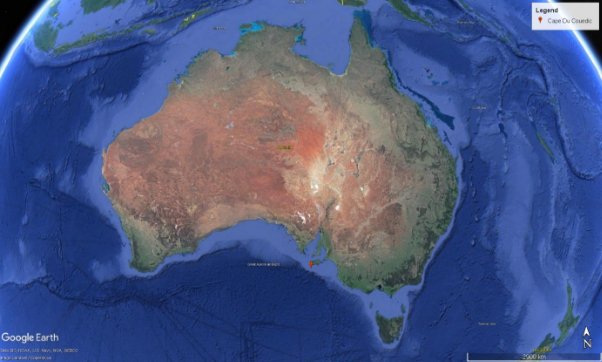
Figure 3. Location of Cape du Couedic Lighthouse within Australia (Map data: Google Earth, SIO, NOAA, U.S. Navy, NGA, GEBCO. Image: Landsat/Copernicus)
2.2 Setting and landscape
The lighthouse is situated within Flinders Chase National Park. Comprised of three parcels of land, the park has an area of approximately 326.61 kilometres-squared.
The lightstation, constructed on a far south-western promontory of the island, consists of the lighthouse tower, three former keepers’ cottages and store room. The collection of buildings are all within close proximity to each other on the promontory, and contribute to the visual aesthetic of the region. Although the lighthouse tower is the only building to have retained its original function, the site demonstrates a relatively intact lightstation.
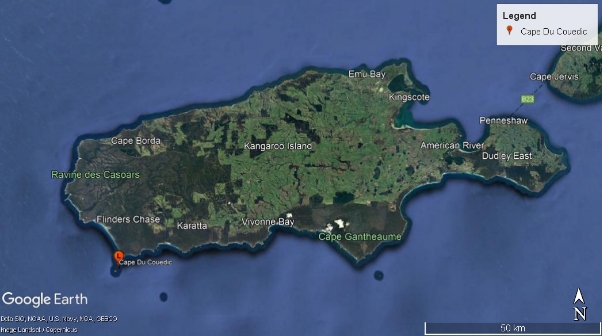 Figure 4. Location of Cape du Couedic Lighthouse along Kangaroo Island coast (Map data: Google Earth, SIO, NOAA, U.S. Navy, NGA, GEBCO. Image: Landsat/Copernicus)
Figure 4. Location of Cape du Couedic Lighthouse along Kangaroo Island coast (Map data: Google Earth, SIO, NOAA, U.S. Navy, NGA, GEBCO. Image: Landsat/Copernicus) 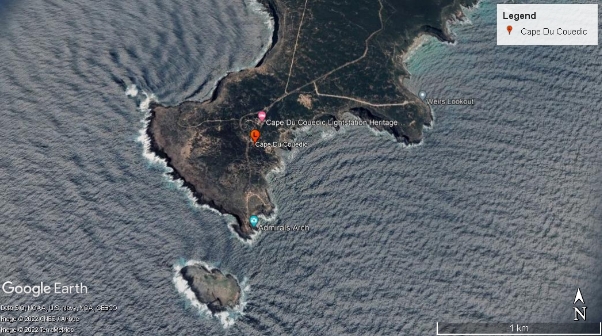
Figure 5. Location of lighthouse on Cape du Couedic (Map data: Google Earth, SIO, NOAA, U.S. Navy, NGA, GEBCO. Image: © 2022 CNES/Airbus, © 2022 TerraMetrics)
Fauna and flora
Kangaroo Island is considered a sanctuary for a number of floral and faunal species. Most species observed today were introduced around the turn of the 20th century. Flinders Chase National Park is also classified as an International Union for the Conservation of Nature Category II Protected Area.
Faunal species include:
- Tammar wallaby (Macropus eugenii)
- Platypus (Ornithorhynchus anatinus)
- Koala (Phascolarctos cinereus)
- New Zealand fur-seal (Arctocephalus forsteri)
- Western grey kangaroo (Macropus fuliginosus fuliginosus)
Bird species on Kangaroo Island include:
- Glossy black cockatoo (Calyptorhynchus lathami)
- White-bellied sea-eagle (Haliaeetus leucogaster)
- Osprey (Pandion haliaetus)
- Bush stone-curlew (Burhinus grallarius)
- Australian bittern (Botaurus poiciloptilus)
- Shy heath-wren (Hyacola cauta)
- Bassian thrush (Zoothera lunulata)
- Shining bronze-cuckoo (Chrysococcyx lucidus)
- Hooded plover (Thinornis rubricollis)
- Cape Barren goose (Cereopis novaehollandiae)
- Fairy tern (Sterna nereis)
Various feral species such as goat, pig and cat exist on the island with various strategies in place to contain such populations.
Native floral species on Kangaroo Island include:
- Late donky orchid (Diuris brevifolia)
- Kangaroo Island daisy (Achnophora tatei)
- Twining finger flower (Cheiranthera volubilis)
- Island logania (Logania insularis)
Further information on the fauna and flora of Kangaroo Island can be accessed from the ‘Flinders Chase National Park, Kelly Hill Conservation Park, Ravine des Casoars Wilderness Protection Area and Cape Bouguer Wilderness Protection Area Management Plans’.[v] 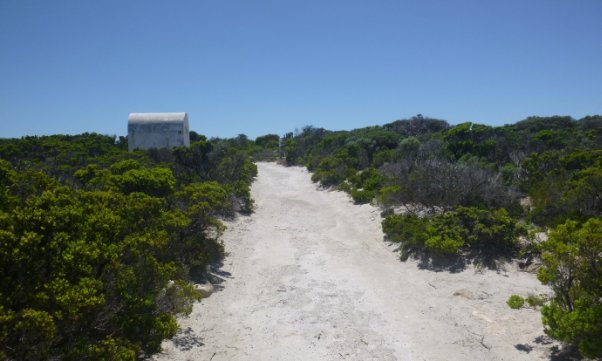
Figure 6. Surrounding vegetation on Cape du Couedic (© AMSA, 2020)
2.3 Lease and management
AMSA lease the lighthouse and land from the SA Department for Environment and Water (DEW), the state body responsible for Flinders Chase National Park.
The AMSA lease consists of two parcels of land:
- Lot A: GP 608/1993
- Lot B: GP 608/1993 (approximately 100 meter-squared)
The lighthouse tower sits within Lot B. The current lease was signed 8 December 1993.
The lease stipulates that AMSA must comply with any applicable management plan and State environmental laws. In the case of Cape du Couedic, AMSA must comply with the Flinders Chase National Park, Kelly Hill Conservation Park, Ravine des Casoars Wilderness Protection Area and Cape Bouguer Wilderness Protection Area Plan of Management.[vi] 
Figure 7. Cape du Couedic Lighthouse Map of Lease, 2017 (Map data: DigitalGlobe Imagery Tile Service, DigitalGlobe Inc. ESRI World Streetmap)
2.4 Access
Kangaroo Island can be accessed by either ferry or authorised plane/helicopter. Sealed roads are found across the Island. A sealed road, Cape du Couedic Road, runs to the lightstation with parking available. Pedestrians can travel approximately 60 metres from the road along Lighthouse Heritage Walk to reach the foot of the tower, where access around the external base is possible.
Due to internal hazards and the installation of critical navigational equipment, access inside the lighthouse tower is restricted to authorised personnel and AMSA employees and contractors.
2.5 Listings
Cape du Couedic Lighthouse is listed on the following heritage registers:
List | ID |
Commonwealth Heritage List | 105414[vii] |
South Australian Heritage Register | 10398[viii] |
Register of the National Estate | 7436[ix] |
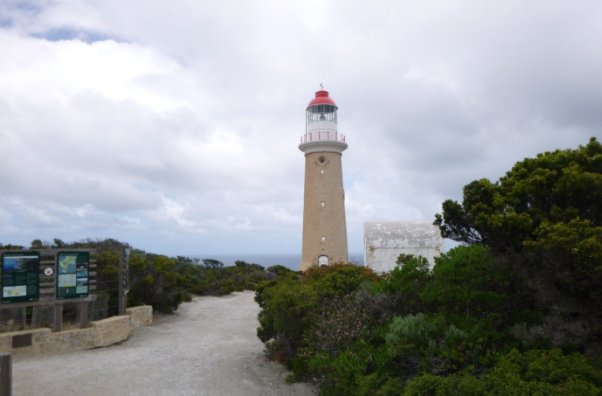 Figure 8. Access path to Cape du Couedic Lighthouse tower (© AMSA, 2021)
Figure 8. Access path to Cape du Couedic Lighthouse tower (© AMSA, 2021)

3. History
3.1 General history of lighthouses in Australia
The first lighthouse to be constructed on Australian soil was Macquarie Lighthouse, located at the entrance to Port Jackson, NSW. First lit in 1818, the cost of the lighthouse was recovered through the introduction of a levy on shipping. This was instigated by Governor Lachlan Macquarie, who ordered and named the light.
The following century oversaw the construction of hundreds of lighthouses around the country. Constructing and maintaining a lighthouse were costly ventures that often required the financial support of multiple colonies. However, they were deemed necessary aids in assisting the safety of mariners at sea. Lighthouses were firstly managed by the colony they lay within, with each colony developing their own style of lighthouse and operational system. Following Federation in 1901, which saw the various colonies unite under one Commonwealth government, lighthouse management was transferred from state hands to the Commonwealth Lighthouse Service.
Lamps and optics: an overview
Lighthouse technology has altered drastically over the centuries. Eighteenth century lighthouses were lit using parabolic mirrors and oil lamps. Documentation of early examples of parabolic mirrors in the United Kingdom, circa 1760, were documented as consisting of wood and lined with pieces of looking glass or plates of tin. As described by Searle, “When light hits a shiny surface, it is reflected at an angle equal to that at which it hit. With a light source is placed in the focal point of a parabolic reflector, the light rays are reflected parallel to one another, producing a concentrated beam”.[x]
In 1822, Augustin Fresnel invented the dioptric glass lens. By crafting concentric annular rings with a convex lens, Fresnel had discovered a method of reducing the amount of light absorbed by a lens. The Dioptric System was adopted quickly with Cordouran Lighthouse (France), which was fitted with the first dioptric lens in 1823. The majority of heritage-listed lighthouses in Australia house dioptric lenses made by others such as Chance Brothers (United Kingdom), Henry-LePaute (France), Barbier, Bernard & Turenne (BBT, France) and Svenska Aktiebolaget Gasaccumulator (AGA of Sweden). These lenses were made in a range of standard sizes, called orders—see ‘Appendix 2. Glossary of lighthouse Terms relevant to Cape du Couedic Lighthouse’.
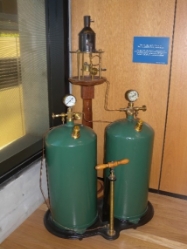
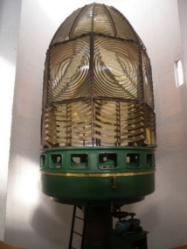
Figure 9. Incandescent oil vapour lamp by Chance Brothers (Source: AMSA)
Figure 10. Dioptric lens on display at Narooma (Source: AMSA)
Early Australian lighthouses were originally fuelled by whale oil and burned in Argand lamps, and multiple wicks were required in order to create a large flame that could be observed from sea. By the 1850s, whale oil had been replaced by colza oil, which was in turn replaced by kerosene, a mineral oil.
In 1900, incandescent burners were introduced. This saw the burning of fuel inside an incandescent mantle which produced a brighter light with less fuel within a smaller volume. Light keepers were required to maintain pressure to the burner by manually pumping a handle as can be seen in Figure 9.
In 1912, Swedish engineer Gustaf Dalén, was awarded the Nobel Prize in physics for a series of inventions relating to acetylene-powered navigation lights. Dalén’s system included the sun valve, the mixer, the flasher, and the cylinder containing compressed acetylene. Due to their efficiency and reliability, Dalén’s inventions led to the gradual destaffing of lighthouses. Acetylene was quickly adopted by the Commonwealth Lighthouse Service from 1915 onwards.
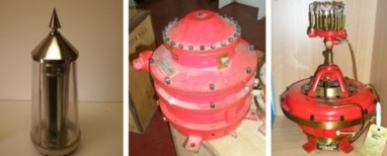
Figure 11. Dalén's system - sunvalve, mixer and flasher (Source: AMSA)
Large dioptric lenses, such as that shown in Figure 10, gradually decreased in popularity due to cost and the move towards unmanned automatic lighthouses. By the early 1900s, Australia had stopped ordering these lenses with the last installed at Eclipse Island in Western Australia in 1927. Smaller Fresnel lenses continued to be produced and installed until the 1970s when plastic lanterns, still utilising Fresnel’s technology, were favoured instead. Acetylene remained in use until it was finally phased out in the 1990s.
In the current day, Australian lighthouses are lit and extinguished automatically using mains power, diesel generators, and solar-voltaic systems.
3.2 The Commonwealth Lighthouse Service
When the Australian colonies federated in 1901, they decided that the new Commonwealth government would be responsible for coastal lighthouses—that is, major lights used by vessels travelling from port to port—but not the minor lights used for navigation within harbours and rivers. There was a delay before this new arrangement came into effect. Existing lights continued to be operated by the states.
Since 1915, various Commonwealth departments have managed lighthouses. AMSA, established under the Australian Maritime Safety Authority Act 1990 (Cth), is now responsible for operating Commonwealth lighthouses and other aids to navigation, along with its other functions.
3.3 Cape du Couedic: a history
Aboriginal history
Kangaroo Island has an extensive history, and the island is embedded in the Ngurunderi Dreaming Story.
Ngurunderi, an ancestral being, chased two of his wives along the coastline of Encounter Bay. When they tried to cross the waters to Kangaroo Island, Ngurunderi made the ocean rise and flood what is now known as Backstairs Passage. His wives were drowned and became the Pages Islands. Ngurunderi then travelled to Kangaroo Island where, at the far end of the island at Admiral’s Arch, he threw his spears down into the sea which created the Casuarina Islets. Ngurunderi then cleansed himself in the ocean before passing into the spirit world.
More than 100 cultural heritage sites, which include stone artefact scatters, have been uncovered on the island, and radiocarbon dating undertaken on the western end of the island demonstrated the presence of Aboriginal groups for thousands of years.
Sally, also known as Kalinga and Princess Con, is a notable figure in the history of the island. Sally was the daughter of King Condoy, the headman of Ramindjeri. In the late 1820s, Sally was taken from her home in Cape Jervis by sealers to King George Sound, and then onto Kangaroo Island by the early 1830s. She later married William Walker and had two sons, George and Joseph who were both born on the island.
Early European history
Kangaroo Island was first sighted by British explorer Matthew Flinders aboard the HMS Investigator on 23 March 1802. Flinders had landed on the north coast of Dudley Peninsula and, after noting the large number of western grey kangaroo present, named the landmass ‘Kangaroo Island’.[xi] The island was circumnavigated and mapped by French explorer Commander Nicolas Baudin’s party aboard the Le Geographe, and the Le Casurina where the south coast was surveyed. The cape was named after celebrated French captain Charles Louis Chevalier du Couedic de Kergoualer, however some maps erroneously spelt it as Cape du Couedie which was not rectified until 1905.[xii]
In 1836, the First Fleet of South Australia reportedly stopped in at the island’s Nepean Bay en route to the mainland. These ships, such as the Duke of York, the Lady Mary Pelham, and the Africaine, carried the first European settlers that would establish the city of Adelaide and the colony of South Australia. The first colonial settlement on Kangaroo Island was Kingscote (originally Reeves Point) established in July 1836.[xiii]
The 1840s saw the operation of whaling stations on the island’s coastline. Shipping around Kangaroo Island also grew exponentially during this time period as the island sat on either side of the Backstairs Passage and the Investigator Strait, two key shipping routes. Increased shipping led to many instances of shipwrecks around the island, which in turn led to the construction of lighthouses: Cape Willoughby in 1852 and Cape Borda in 1858.
3.4 Why Cape du Couedic?
Up until 1909, vessels travelling from the western Australian coastline to the eastern colonies were left blind until reaching Cape Borda Lighthouse on the north-western coast of Kangaroo Island. However, the light from Cape Borda was often obscured from the view of ships traversing waters close to the island if carried in strong currents too far south.[xiv] The consequence of this was reflected in the loss of both ships and life.
By the end of the 19th century, a number of vessels had been lost in the waters by the island. In 1877, the Emily Smith was wrecked in the vicinity with a loss of life, and the Mars was wrecked in 1885 with eight lives lost.[xv] However the largest disaster occurred on 24 April 1899, when the Loch Sloy was wrecked on breakers by the island. 31 lives were lost, with four men managing to swim to shore. Three of the men were able to make it to nearby civilisations, however one man perished.[xvi]
Public outrage ensued following the wrecking, and the government was criticised for a lack of consideration for sailors traversing a dangerous coast. In the months following the loss of the Loch Sloy, the Marine Board consulted with mariners, presenting to them two possible positions for a light: South Neptune Island and Cape du Couedic. Of the two, South Neptune Island was favoured by the mariners as it was determined that a light on this position would assist vessels carried by an easterly current to a position where the Cape Borda light was obscured by cliffs.[xvii] However, Captain P. Weir of Adelaide argued the following:
‘The south side of Kangaroo Island is, however, exceedingly dangerous by reason of the rocky coast and the reefs which abound, and is without a single lighthouse to warn mariners of their danger….Had this lighthouse [Cape du Couedic] been in existence the Loch Sloy would probably have been afloat to-day, and many lives would have been spared.’[xviii]
No immediate action was taken following these discussions, and in 1905, the Loch Vennachar was wrecked between Cape Borda and Cape du Couedic. Twenty-six lives were lost, and the government faced increasing pressure for a lighthouse to be constructed.[xix] Finally, Cape du Couedic was chosen as the site.
3.5 Building a lighthouse
Design
The original designs of the proposed Cape du Couedic Lighthouse were created by Mr J.B. Labatt, Assistant Engineer of Harbours, and included a sandstone tower with concrete balcony and staircase.[xx] The ground floor design also depicted two front doors, an inner and outer door. The purpose of this design was to ensure winds from the lighthouse would not impact the two sector lights located on the ground floor. Only one set of doors were permitted open at any one time.[xxi]
Construction
Workmen first arrived on Kangaroo Island on 4 October 1907, and a jetty at Weir’s Cove approximately one kilometre from site was the first structure to be built. These works were overseen by Inspector G. Wisdom. Initially, materials for the station were carted up a zig-zag path up the cliffs before a flying fox was constructed, enabling materials to be towed up the cliff instead.[xxii]
The works on the lightstation were overseen by Labatt and a Mr Lucas. Sandstone for the tower and cottages were quarried locally, and by early 1909, despite battling the elements on an exposed site, the construction of the tower was well underway. Three cottages were constructed of sandstone, and positioned in a low-lying area so as to reduce the impact from the winds on the cape.[xxiii]
Captain Weir suggested a temporary light be exhibited throughout the duration of the construction, and the masthead light from Weir’s ship, the Governor Musgrave, was installed onsite and maintained by the workmen.
In the tower itself, two sector lights, one red, one white, were installed in order to warn vessels of the nearby Lipsons Reef and Casuarina Islands. A 12’9” Chance Bros. lantern was constructed at the top of the sandstone tower, and a 1st Order 6 panel lens installed.

Figure 12. Cape du Couedic Lighthouse: Outline drawing showing inside and outside galleries to be constructed ready for fixing, 1909. Image courtesy of the NAA: A9568, 4/8/1 (© Commonwealth of Australia, National Archives of Australia)[xxiv]
Equipment when built
The Cape du Couedic light was first exhibited on 27 June 1909. The event was attended by members of the Marine Board including the President Mr Arthur. Labatt was also present at the event, however inclement weather forbade members from disembarking. When the light was lit for the first time by the keepers, the Marine Board members watched from the Governor Musgrave captained by Weir. The event was therefore considered a ‘keen disappointment’.[xxv]
The lighthouse stood as a 17 metre sandstone tower with a red and white Chance Bros. lantern. Although records determined the tower was painted with red and white bands, it is believed the tower was bare sandstone as found at the site today.[xxvi] It was reported in the ‘Notice to Mariners’ that the light was double-flashing, with each flash lasting for 7.5 seconds, and an eclipse of 0.33 seconds. The tower was accompanied by the three sandstone keepers’ cottages which was approximately 160 metres from the lighthouse. It is believed the total cost of the lightstation was around £16,000.[xxvii]
Light keeping
The first keepers to be stationed at Cape du Couedic were Mr. G.G. Duthie as Headkeeper, Mr G. E. Luckett as second-keeper, and Mr G. Marment as third-keeper. All three men were described as coming from experienced lightkeeping backgrounds, Duthie had previously been stationed at Troubridge Shoal, and Luckett had worked at Cape Northumberland Lighthouse prior to his posting at Cape du Couedic.[xxviii] Despite this experienced team, life at the station was not without peril. In 1910, just 13 months after Cape du Couedic was first lit, third keeper Marment was drowned near South Neptune Island while fishing.[xxix] 
Figure 13. Cape du Couedic Lighthouse, 1917. Image courtesy of the NAA: A6247, A56/2 (© Commonwealth of Australia, National Archives of Australia)[xxx]
An oversight in the lighthouse’s construction also resulted in serious injuries. The lantern
installed at the tower did not arrive with an internal or external catwalk which made cleaning the lantern glazing difficult. The Headkeeper in 1929, H.H. Beare, broke his ribs and suffered internal injuries when he fell approximately 21 metres from the tower while cleaning the glazing. After great difficulty in getting Beare to Kingscote via car, and then onto Adelaide by air, he made a full recovery.[xxxi]
Due to the rough road to the lighthouse, supplies were delivered via steamer and carried up the haulage way. Mail was delivered by horseback fortnightly.[xxxii] By the early 1950’s, shipping along Kangaroo Island had subsided considerably with vessels using Backstairs Passage and Investigator Strait instead.[xxxiii] By 1957, the lighthouse was automated and the keeper positions were terminated.
Keepers remained stationed at Cape du Couedic Lighthouse until the light was automated in 1957. The land was transferred to the State of South Australia with the Commonwealth retaining management of the lighthouse tower.
In 2019-2020, up to 96% of the Flinders Chase National Park was consumed by bushfires. The lightstation was left intact and unharmed.
3.6 Chronology of major events
The following table details the major events to have occurred at Cape du Couedic Lighthouse.
Date | Event |
27 June 1909 | Light first exhibited.[xxxiv] |
1910 | Third keeper G. Marment drowned at South Neptune Island while fishing. Body recovered several weeks later.[xxxv] |
1919 | Flinders Chase National Park established.[xxxvi] |
1929 | Headkeeper Beare falls from the external catwalk and is taken to Adelaide with broken ribs and internal injuries.[xxxvii] |
1940 | First motor vehicle visit to Cape du Couedic.[xxxviii] |
1951 | The staffed future of Cape du Couedic Lighthouse called into question after keepers reported seeing only 15 ships pass the lighthouse across three years.[xxxix] |
1957 | Lighthouse automated and keeper positions terminated. |
1959 | Cape du Couedic Lighthouse reserve, excluding the tower and storage shed, were sold to the Flora and Fauna Board of South Australia.[xl] |
1980 | Cape du Couedic Lighthouse listed on the South Australian Heritage Register. |
1991 | Keepers cottages restored and made available for tourist accommodation.[xli] |
2004 | Cape du Couedic Lighthouse listed on the Commonwealth Heritage List. |
2007 | 60,000 hectares of Flinders Chase National Park and nearby Ravine des Casoars Wilderness Protection Area lost in bushfires. |
2020 | Bushfires destroy parts of Flinders Chase National Park, lighthouse tower and cottages left unscathed. |
3.7 Changes and conservation over time
The following section details the changes and conservation efforts to have been carried out at Cape du Couedic Lighthouse since its construction.
The Brewis Report
Commander CRW Brewis, retired naval surveyor, was commissioned in 1911 by the Commonwealth Government to report on the condition of existing lights and to recommend any additional ones. Brewis visited every lighthouse in Australia between June and December 1912, and produced a series of reports published in their final form in March 1913. These reports were the basis for future decision-making for the individual lighthouses and provide a snapshot of the Cape du Couedic lightstation in the early 20th century.[xlii]
Cape Couedic Light. (147 miles from Adelaide; 27 miles from Cape Borda.) Lat. 35° 46’ S., Long. 136° 42’ E., Chart No. 2389 (a). – Established 1909. Character.- Main Light.- One white, group flashing two short flashes ea. One-third sec. in quick succession every seven and a-half seconds. Dioptric, 1st Order, 439,000 c.p. Illuminant, vaporized kerosene; 85mm. incandescent mantle. Circular stone tower, 58 feet, red and white bands. Height of focal plane, 339 feet. Subsidary Light. – One white, with red sectors. Fixed, Dioptric. Candle-power – white, 10,000; red, 2,500. Same tower as main light. Height of focal plane, 279 feet. Visibility.- Main Light. – From seaward, in clear weather, for a distance of 25 nautical miles. Subsidary Light. – Red, fixed, through an arc of 30 degrees from 359 ½ (N. 5 W., Mag). to 29 ½ (N. 25 E., Mag.), and obscured elsewhere. Visible in clear weather – white, 21 nautical miles; red, about 10 nautical miles. Optical Apparatus. – Main Light. – Chance Bros., 1909. Dioptric, 1st Order. Focal radius, 36 inches. Six panels, each 60 degrees horizontal angle. Upper and lower reflecting prisms. Revolved on mercury float. One complete revolution every 22 ½ seconds. Condition and state of efficacy. – The tower, apparatus, quarters, and equipment are modern, and in good condition. No Morse signals. These are undesirable, on account of outlying dangers. Rocket signals are fired to warn vessels running into danger. Three light-keepers are stationed here. Communication. – Telephone to Cape Borda Light, 47 miles (no road); thence to Kingscote and main telegraph system. Mails fortnightly from Kingscote by road, distant 70 miles. Visited periodically by Government Steamer. Landing at pier below light station. Fogs. – Fog was only experienced on two occasions in the year 1911. One lasted twenty minutes, and the other fourteen hours. Soundings. – Off-lying dangers extend for a distance of 26 miles to the southward of Kangaroo Island. Vessels should, in thick weather, give this part of the coast a wide berth, and maintain a depth of over 60 fathoms – the more the better. RECOMMENDATION. – Nil. |
Alteration to the light
The following table details the changes to the Cape du Couedic light since its exhibition in 1909.
Date | Alteration |
1909 | Chance Bros. 12’9” lantern, 1st Order 6-panel lens with 85mm burner. 3rd Order auxiliary light with two sectors, red and white. |
1917 | 3rd Order auxiliary light discontinued. |
c.1922 | Intensity: 439,000 candelas. |
1957 | 1st Order 6-panel lens removed. Replaced with 375mm Chance Bros. lens. Light converted to automatic acetylene operation and station de-staffed. |
July 1974 | Light converted to electric operation. Intensity: 38,000 candelas. |
2008 | Optic upgraded to Halogen lamp. Intensity: 17,386 candelas. |
2020 | Optic upgraded to LED lighthouse source. |
For information on current light details, see ‘Appendix 4 Cape du Couedic Lighthouse current light details’.
Recent conservation works
The following table details the recent conservation works to have occurred at Cape du Couedic Lighthouse.
Date | Work |
1910 | Catwalk installed at lighthouse. |
1957 | Five catwalk floor panels and their brackets removed, and infill floor installed at catwalk level, with timber planks supported on rolled steel joists spanning across the top of the lantern base for acetylene conversion. 1st Order lens and pedestal removed and sent to Eddystone Point Lighthouse (Tasmania). |
2015 | Lantern room and upper ring repainted, glazing resealed and broken glazing panes replaced. |
3.8 Summary of current and former uses
From its construction in 1909, Cape du Couedic Lighthouse has been used as a marine AtoN for mariners at sea. Its AtoN capability remains its primary use.
The cottages, once used to house the keepers stationed at Cape du Couedic Lighthouse, were utilised by Flinders University circa. 1980s. At the time this plan was written, the Cape du Couedic cottages are used for tourist accommodation under the management of SA Tourism Kangaroo Island.
3.9 Summary of past and present community associations
Aboriginal associations
The Cape du Couedic landscape maintains high significance due to its long Aboriginal history, and its part within the Ngurunderi Dreaming Story.
The Ramindjeri Heritage Association Inc. draw direct connection to King Condoy, headman of Ramindjeri, and Princess Con. Ramindjeri people observe the island to be a ‘gateway to heaven’, and maintain strong ties to the island and the Cape du Couedic landscape.
Local, national and international associations
Cape du Couedic Lighthouse is considered a significant site to the Kangaroo Island community, as well as to the wider state and national communities due to the site’s contribution to the history of maritime development in the early 20th century. There are also strong familial connections with the site due to its time as a staffed station from 1909-1957. The shipwrecks that occurred close to the cape have also cemented the site as one of tragedy and loss.
The surrounding Flinders Chase National Park is notable for its associations with national and international conservation efforts.
3.10 Unresolved questions or historical conflicts
A few dates are contested across various sources. Lighthouses of Australia Inc. determine that construction of the lightstation began in 1906, whereas Garry Searle in their publication “First Order: Australia’s highway of Lighthouses” determines that construction workers first arrived on Kangaroo Island in 1907, and that construction of the lighthouse did not commence until the jetty has been completed.
A full list of the keepers to have been stationed at Cape du Couedic is not available, however a partial list was compiled by Lighthouse of Australia Inc. and the Duthie Family and in available on the Lighthouses of Australia Inc. website.[xliii]
3.11 Recommendations for further research
Further investigation on the families stationed at the lightstation would provide greater insight into the social history of the lighthouse during its staffed life-span.

4. Fabric
4.1 Fabric register
The cultural significance of the lighthouse resides in its fabric, and also in its intangible aspects, such as the meanings people ascribe to it, and the connections to other places and things. The survival of its cultural value depends on a well-informed understanding of what is significant, and on clear thinking about the consequences of change. The Burra Charter sets out good practice for conserving cultural significance.
Below, each part of the lighthouse is listed and the description, condition and significance of each part is discussed. Criterion listed under ‘Heritage Significance’ refer to the criterion satisfied within the specific Commonwealth heritage listing (see ‘Section 5.1’).
Lighthouse feature: Lantern roof
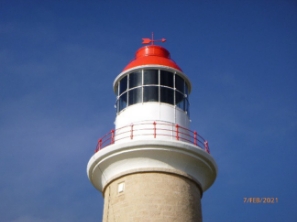
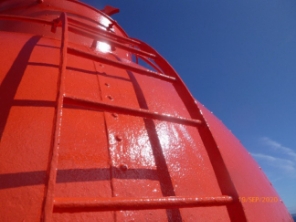
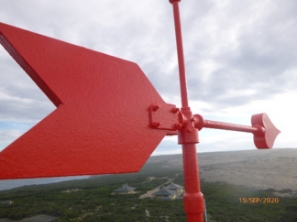
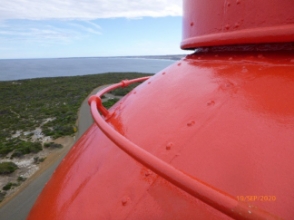
© AMSA 2020
Description and condition
1909 Chance Bros part-spherical dome of copper sheets lapped and screwed.
- Ribs – not visible but presumed to be cast iron radial ribs
- Inner skin – copper sheets screw fixed to ribs
- Ventilator – drum type with wind vane attached
- Wind vane – fixed
- Gutter – circular ring of cast iron pieces bolted together
- External ladder – curved iron ladder fixed to outside of roof
- Handrails – one circular hand rail attached to lantern roof, another attached to top of ventilator drum
- Ladder rail – has been removed and stored on the intermediate landing within the lighthouse
- Downpipes – have been removed and stored on the intermediate landing within the lighthouse
- Curtain rail – continuous rail attached to inner skin of roof
- Drip tray – copper dish suspended under ventilator, with central hole for heat tube
Finish: | painted |
Condition: | intact and sound |
Integrity: | high |
Significance: | high |
Maintenance: | keep in service, prepare and repaint at normal intervals |
Rectification works: | none |
Heritage significance: High
The lantern roof is an original feature of the last lighthouse to be built in South Australia by the State Government, a site associated with the State’s maritime and economic history (criterion a).
The lantern roof is an original feature of a relatively intact early 20th century lightstation complex (criterion d).
The lantern roof contributes to the prominent aesthetic qualities of the tower (criterion e).
Lighthouse feature: Lantern glazing
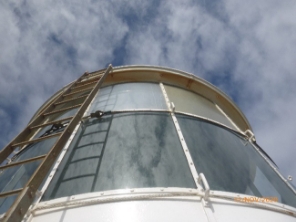
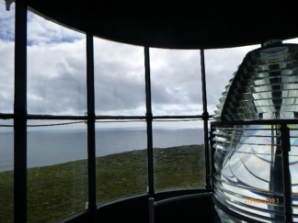
© AMSA 2021
Description and condition
1909 Chance Bros, cylindrical in form.
- Panes – curved rectangular glass, three tiers
- Astragals – vertical astragals of rectangular section iron, bolted to gutter ring at top, and to lantern base below. Horizontal astragals of triangular section.
Finish: | astragals, cover strips and blank panels: painted blank panels are formed of FRP |
Condition: | intact and sound |
Integrity: | high |
Significance: | high |
Maintenance: | keep in service, reglaze as necessary, prepare and repaint at normal intervals |
Rectification works: | none |
Heritage significance: High
The lantern glazing is an original feature of the last lighthouse to be built in South Australia by the State Government, a site associated with the State’s maritime and economic history (criterion a).
The lantern glazing is an original feature of a relatively intact early 20th century lightstation complex (criterion d).
The lantern glazing is an original feature of the lighthouse and contributes to its prominent aesthetic qualities (criterion e).
Lighthouse feature: Internal catwalk



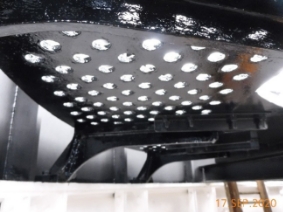
© AMSA 2019
Description and condition
Post 1910 Chance Bros, cast iron lattice floor panels supported on solid cast iron brackets bolted to top of the lantern base.
- 1957 modification for acetylene conversion – five catwalk floor panels and their brackets removed, and infill floor installed at catwalk level, with timber planks supported on rolled steel joists spanning across the top of the lantern base. Galvanized pipe handrails and stanchions around access openings.
- Ladder – fixed timber ladder with treads housed into strings
Finish: | painted |
Condition: | intact and sound |
Integrity: | high |
Significance: | high |
Maintenance: | keep in service, prepare and repaint at normal intervals |
Rectification works: | none |
Heritage significance: High
The internal catwalk is an early feature of the last lighthouse to be built in South Australia by the State Government, a site associated with the State’s maritime and economic history (criterion a).
The internal catwalk is an early feature of a relatively intact early 20th century lightstation complex (criterion d).
Lighthouse feature: Lantern base
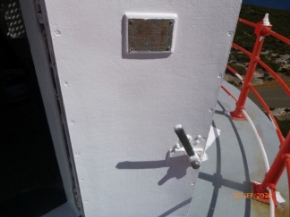
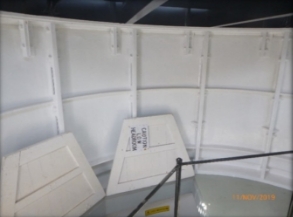
 © AMSA 2020
© AMSA 2020
Description and condition
1909 Chance Bros, cylindrical in form. Curved panels of cast iron bolted together with flanged joints.
- Internal lining – none (removed)
- Vents – two horizontal slots in the bottom exterior of each panel, blocked off
- Door – Chance Bros, iron skin with flat frame applied outside; iron inner frame and lining. Copper alloy hinges. Copper alloy mortise lock; inside knob replaced by steel lever, but outside bar handle still in place. Maker’s plaque attached to door.
Finish: | painted |
Condition: | intact and sound |
Integrity: | high |
Significance: | high |
Maintenance: | keep in service, prepare and repaint at normal intervals |
Rectification works: | none |
Heritage significance: High
The lantern base is an original feature of the last lighthouse to be built in South Australia by the State Government, a site associated with the State’s maritime and economic history (criterion a).
The lantern base is an original feature of a relatively intact early 20th century lightstation complex (criterion d).
The lantern base is an original feature of the lighthouse and contributes to its prominent aesthetic qualities (criterion e).
Lighthouse feature: Lantern floor
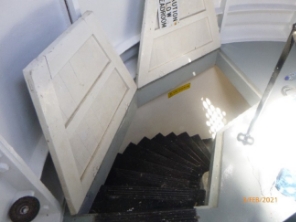
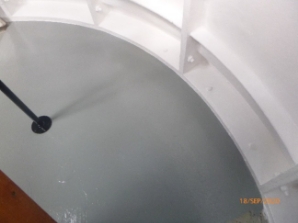
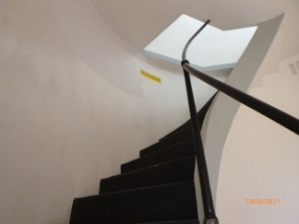
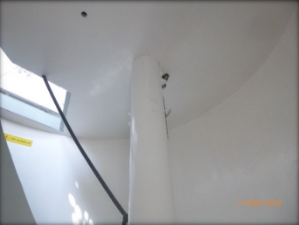
© AMSA 2021
Description and condition
1909 reinforced concrete floor slab.
- Access – stair covered by two trapezoidal timber framed and sheeted covers. Steel handrail.
Finish: | painted |
Condition: | intact and sound |
Integrity: | high |
Significance: | high |
Maintenance: | keep in service, prepare and repaint at normal intervals |
Rectification works: | none |
Heritage significance: High
The lantern floor is an original feature of the last lighthouse to be built in South Australia by the State Government, a site associated with the State’s maritime and economic history (criterion a).
The lantern floor is an original feature of a relatively intact early 20th century lightstation complex (criterion d).
Lighthouse feature: Lens assembly
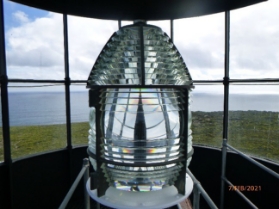 © AMSA 2021
© AMSA 2021
Description and condition
1957 Chance Bros 375mm focal radius fixed lens assembly.
Condition: | intact and sound |
Integrity: | high |
Significance: | moderate |
Maintenance: | keep in service, prepare and repaint at normal intervals |
Rectification works: | none |
Heritage significance: Moderate
The 1957 Chance Bros. lens is an important addition to the last lighthouse to be built in South Australia by the State Government, a site associated with the State’s maritime and economic history (criterion a).
Lighthouse feature: Optical apparatus
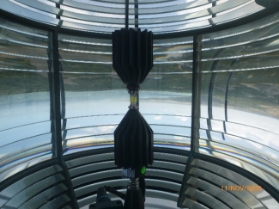 © AMSA 2019
© AMSA 2019
Description and condition
Sealite SL-LED-216-W.
Condition: | intact and sound |
Integrity: | high |
Significance: | low |
Maintenance: | keep in service |
Rectification works: | none |
Heritage significance: Low
The optical apparatus is of low significance.
Lighthouse feature: Pedestal
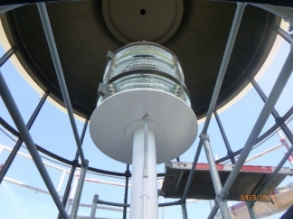
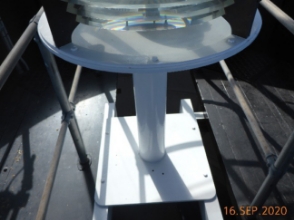 © AMSA 2020
© AMSA 2020
Description and condition
1957 steel tubular post welded to square base plate and circular top plate. The pedestal is supported on two rolled steel beams.
Condition: | sound |
Integrity: | medium |
Significance: | low |
Maintenance: | keep in service, prepare and repaint at normal intervals |
Rectification works: | none |
Heritage significance: Low
The 1957 pedestal is of low significance.
Lighthouse feature: Balcony floor
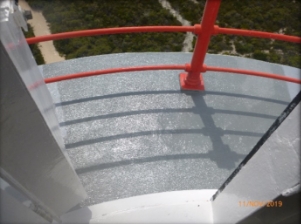

 © AMSA 2019
© AMSA 2019
Description and condition
1909 reinforced concrete slab.
Finish: | membrane painted |
Condition: | intact and sound |
Integrity: | high |
Significance: | high |
Maintenance: | keep in service, prepare and repaint at normal intervals |
Rectification works: | none |
Heritage significance: High
The balcony floor is an original feature of the last lighthouse to be built in South Australia by the State Government, a site associated with the State’s maritime and economic history (criterion a).
The balcony floor is an original feature of a relatively intact early 20th century lightstation complex (criterion d).
The balcony floor is an original feature of the lighthouse and contributes to its prominent aesthetic qualities (criterion e).
Lighthouse feature: Balcony balustrade

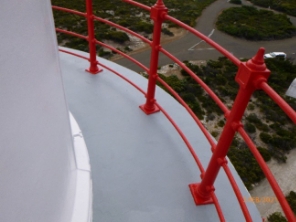
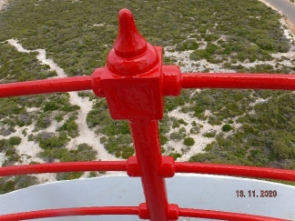 © AMSA 2021
© AMSA 2021
Description and condition
1909 Chance Bros cast iron stanchions with four iron pipe rails.
Finish: | painted |
Condition: | intact and sound |
Integrity: | high |
Significance: | high |
Maintenance: | keep in service, prepare and repaint at normal intervals |
Rectification works: | none |
Heritage significance: High
The balcony balustrades are an original feature of the last lighthouse to be built in South Australia by the State Government, a site associated with the State’s maritime and economic history (criterion a).
The balcony balustrades are an original feature of a relatively intact early 20th century lightstation complex (criterion d).
The balcony balustrades are an original feature of the lighthouse and contributes to its prominent aesthetic qualities (criterion e).
Lighthouse feature: Walls
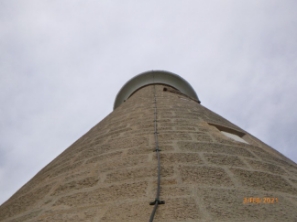
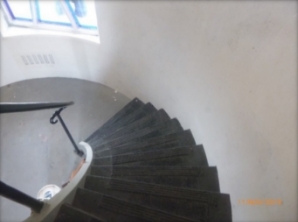 © AMSA 2021
© AMSA 2021
Description and condition
1909 sandstone walls, chisel finish. Plastered inside.
Finish: | external walls: bare stone internal walls: painted |
Condition: | intact and sound, internal paint peeling in some areas, pointing in stone dressing around circular windows needs some minor repair |
Integrity: | high |
Significance: | high |
Maintenance: | keep in service, monitor condition of pointing and stonework, prepare and repaint at normal intervals |
Rectification works: | none |
Heritage significance: High
The walls are an original feature of the last lighthouse to be built in South Australia by the State Government, a site associated with the State’s maritime and economic history (criterion a).
The walls are an original feature of a relatively intact early 20th century lightstation complex (criterion d).
The walls are an original feature of the lighthouse and contributes to its prominent aesthetic qualities (criterion e).
Lighthouse feature: Windows
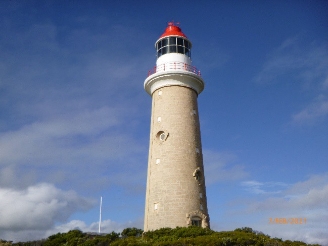 © AMSA 2021
© AMSA 2021
Description and condition
1909 circular windows with glass panes fixed into cast iron frames built into stonework. Rock faced stone dressings around the outside of the openings.
Finish: | cast iron frames: painted glass: clear |
Condition: | intact and sound |
Integrity: | high |
Significance: | high |
Maintenance: | keep in service, prepare and repaint at normal intervals, monitor condition of repointing and stonework (window openings) and reseal as necessary |
Rectification works: | none |
Heritage significance: High
The windows are an original feature of the last lighthouse to be built in South Australia by the State Government, a site associated with the State’s maritime and economic history (criterion a).
The windows are an original feature of a relatively intact early 20th century lightstation complex (criterion d).
Lighthouse feature: Auxiliary light windows
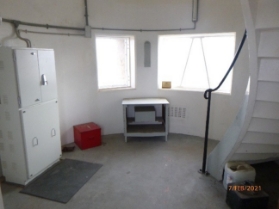 © AMSA 2021
© AMSA 2021
Description and condition
Two 1909 rectangular windows with glass panes fixed in iron frames built into stonework. Rock faced stone dressings around the outside of the openings.
Condition: | intact and sound |
Integrity: | high |
Significance: | high |
Maintenance: | keep in service, prepare and repaint at normal intervals, reseal as necessary |
Rectification works: | none |
Heritage significance:
The auxiliary light windows are an original feature of the last lighthouse to be built in South Australia by the State Government, a site associated with the State’s maritime and economic history (criterion a).
The auxiliary light windows are an original feature of a relatively intact early 20th century lightstation complex (criterion d).
Lighthouse feature: Vents
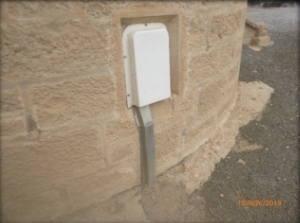
 © AMSA 2019
© AMSA 2019
Description and condition
1909 vent openings incorporated in the tower masonry walls, with recent plastic weatherproof fixed vent cowls.
Finish: | bare plastic |
Condition: | sound |
Integrity: | high |
Significance: | openings: high cowls: low |
Maintenance: | keep in service |
Rectification works: | none |
Heritage significance: High
The vent openings are an original feature of the last lighthouse to be built in South Australia by the State Government, a site associated with the State’s maritime and economic history (criterion a).
The vent openings are an original feature of a relatively intact early 20th century lightstation complex (criterion d).
Lighthouse feature: Doors
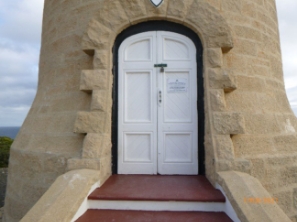
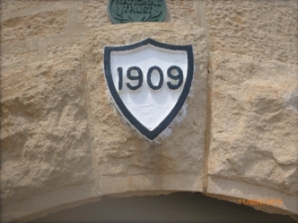

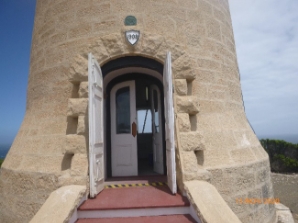
© AMSA 2021
Description and condition
1909 timber doors in timber frames with arched tops.
- Outer doors – a pair of framed door leaves, each with three panels of tongue and groove jointed boards, secured outside with pad-bolt and CLS padlock. Date is mounted above the outer doors.
- Inner doors – a pair of half-glazed door leaves, each with single plain bottom panel. Both leaves have spring closers. One leaf has top and bottom bolts with extended handles, the other has iron cased rim-lock.
Finish: | timber: painted glass: clear |
Condition: | intact and sound |
Integrity: | high |
Significance: | high |
Maintenance: | keep in service, prepare and repaint at normal intervals |
Rectification works: | none |
Heritage significance: High
The doors are an original feature of the last lighthouse to be built in South Australia by the State Government, a site associated with the State’s maritime and economic history (criterion a).
The doors are an original feature of a relatively intact early 20th century lightstation complex (criterion d).
The doors are an original feature of the lighthouse and contribute to its prominent aesthetic qualities (criterion e).
Lighthouse feature: Entrance stair
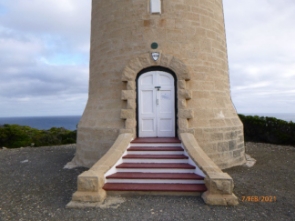
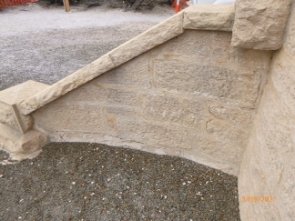
© AMSA 2021
Description and condition
1909 masonry entrance stair with sandstone strings, slate treads, concrete risers.
Finish: | sandstone: bare other surfaces: painted |
Condition: | intact and sound |
Integrity: | high |
Significance: | high |
Maintenance: | keep in service, prepare and repaint at normal intervals |
Rectification works: | none |
Heritage significance: High
The entrance stair is an original feature of the last lighthouse to be built in South Australia by the State Government, a site associated with the State’s maritime and economic history (criterion a).
The entrance stair is an original feature of a relatively intact early 20th century lightstation complex (criterion d).
The entrance stair is an original feature of the lighthouse and contributes to its prominent aesthetic qualities (criterion e).
Lighthouse feature: Intermediate floors
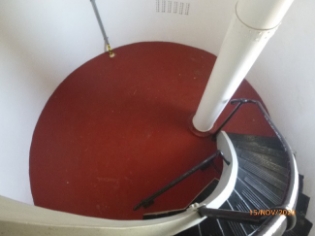 © AMSA 2020
© AMSA 2020
Description and condition
Three 1909 reinforced concrete slab floors.
Ladder rails earlier removed from the lantern are labelled and stored on site on an intermediate floor.
Finish: | painted |
Condition: | intact and sound |
Integrity: | high |
Significance: | high |
Maintenance: | keep in service, prepare and repaint at normal intervals |
Rectification works: | none |
Heritage significance: High
The intermediate floors are an original feature of the last lighthouse to be built in South Australia by the State Government, a site associated with the State’s maritime and economic history (criterion a).
The intermediate floors are an original feature of a relatively intact early 20th century lightstation complex (criterion d).
Lighthouse feature: Stairs
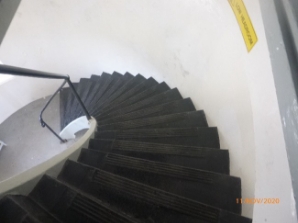
 © AMSA 2020
© AMSA 2020
Description and condition
1909 reinforced concrete geometric stairs with integral string. Single iron handrail on iron stanchions. Extruded zinc strip on lip of each tread.
Finish: | painted |
Condition: | intact and sound |
Integrity: | high |
Significance: | high |
Maintenance: | keep in service, prepare and repaint at normal intervals |
Rectification works: | none |
Heritage significance: High
The stairs are an original feature of the last lighthouse to be built in South Australia by the State Government, a site associated with the State’s maritime and economic history (criterion a).
The stairs are an original feature of a relatively intact early 20th century lightstation complex (criterion d).
Lighthouse feature: Weight tube
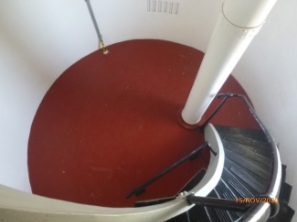
 © AMSA 2020
© AMSA 2020
Description and condition
1909 riveted iron plate tube, off-set from the centre of the tower; between the lantern floor and the first floor of the tower.
Finish: | painted |
Condition: | intact and sound |
Integrity: | high |
Significance: | high |
Maintenance: | preserve, prepare and repaint at normal intervals |
Rectification works: | none |
Heritage significance: High
The weight tube is an original feature of the last lighthouse to be built in South Australia by the State Government, a site associated with the State’s maritime and economic history (criterion a).
The weight tube is an original feature of a relatively intact early 20th century lightstation complex (criterion d).
Lighthouse feature: Ground floor
 © AMSA 2021
© AMSA 2021
Description and condition
1909 reinforced concrete floor slab.
Finish: | painted |
Condition: | intact and sound |
Integrity: | high |
Significance: | high |
Maintenance: | keep in service, prepare and repaint at normal intervals |
Rectification works: | none |
Heritage significance: High
The ground floor is an original feature of the last lighthouse to be built in South Australia by the State Government, a site associated with the State’s maritime and economic history (criterion a).
The ground floor is an original feature of a relatively intact early 20th century lightstation complex (criterion d).
Lighthouse feature: Power supply
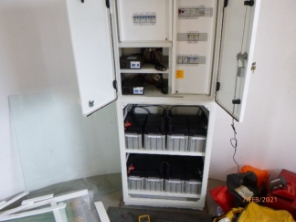
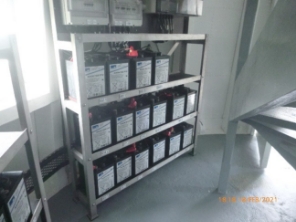
© AMSA 2021
Description and condition
Mains powered with UPS arrangement. All equipment and batteries housed in metal cabinet on ground floor.
Condition: | operational |
Integrity: | high |
Significance: | low |
Maintenance: | keep in service |
Rectification works: | none |
Heritage significance: Low
The power supply is of low significance.
Lighthouse feature: Gravel apron
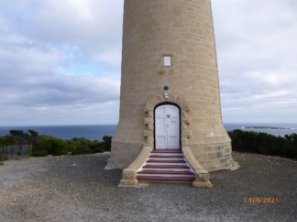
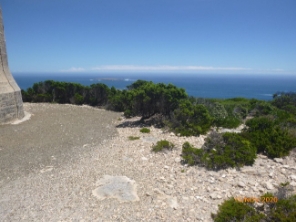 © AMSA 2021
© AMSA 2021
Description and condition
Gravel apron approximately 4.0m wide around the base of the tower.
Finish: | gravel surface |
Condition: | intact and sound |
Integrity: | high |
Significance: | high |
Maintenance: | preserve gravel apron |
Rectification works: | none |
Heritage significance: High
The gravel apron remains part of the original footprint of the last lighthouse to be built in South Australia by the State Government, a site associated with the State’s maritime and economic history (criterion a).
The gravel apron remains part of the original footprint of a relatively intact early 20th century lightstation complex (criterion d).
4.2 Related object and associated AMSA artefacts
The following AMSA artefact/s are currently located at Cape du Couedic Lighthouse.
Artefact description: Thermometer mounted in custom built wooden case | 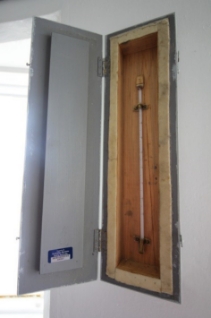 © AMSA 2019 © AMSA 2019
|
Maximo ID: AR0551 |
Location in lighthouse: Ground level wall |
Condition: Good |
| |
Artefact description: Lantern room ladder rail – Cape du Couedic Lighthouse | 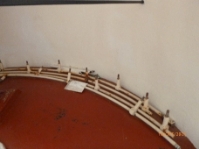 © AMSA 2022 © AMSA 2022
|
Maximo ID: AR0992 |
Location in lighthouse: Intermediate floor |
Condition: Sound, showing signs of corrosion |
| |
Artefact description: Lantern room downpipes – Cape du Couedic Lighthouse | 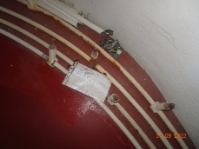 © AMSA 2022 © AMSA 2022
|
Maximo ID: AR0993 |
Location in lighthouse: Intermediate floor |
Condition: Sound, showing signs of corrosion |
4.3 Comparative analysis
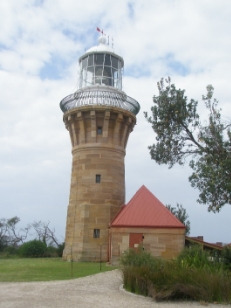
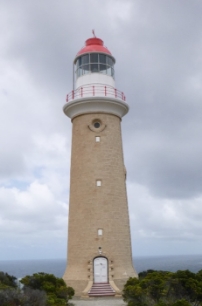
Figure 14. Barrenjoey Lighthouse, NSW (© AMSA, 2009)
Figure 15. Cape du Couedic Lighthouse (© AMSA, 2021)
Cape du Couedic Lighthouse bears some similarities with Barrenjoey Head Lighthouse (New South Wales). Constructed in 1881 under the guidance of Colonial Architect James Barnet, Barrenjoey Lighthouse was constructed of local sandstone which was left bare, as was done with Cape du Couedic. Both Barrenjoey and Cape du Couedic were originally fitted with a Chance Bros. lantern, Barrenjoey’s being slightly smaller measuring 700mm compared to Cape du Couedic’s 920mm.
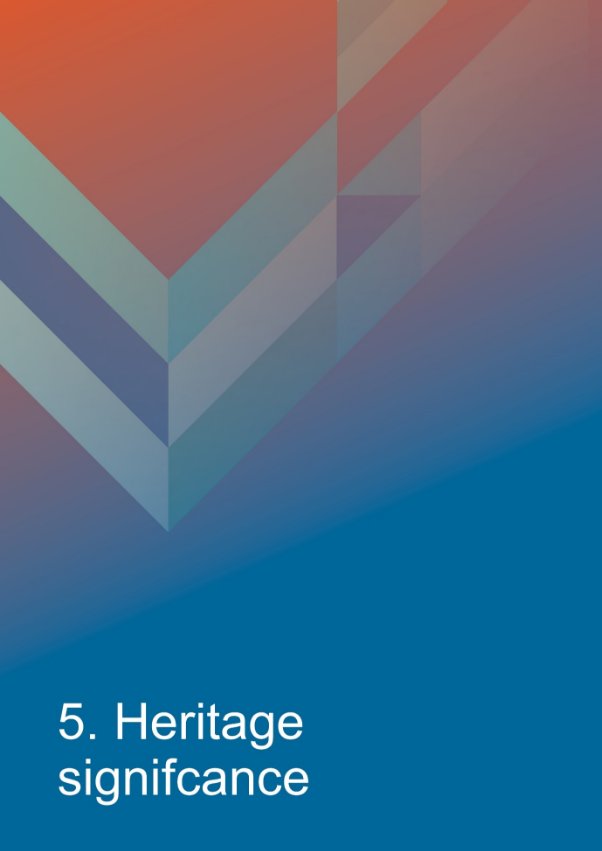
5. Heritage significance
5.1 Commonwealth heritage listing –Cape du Couedic Lighthouse
The following information is taken directly from the Commonwealth Heritage listing for Cape du Couedic Lighthouse (Place ID: 105414).
Commonwealth heritage list – statement of significance
The following statement of significance is taken directly from Cape du Couedic Lighthouse’s Commonwealth heritage listing:
The Cape du Couedic Lighthouse, built in 1909, is significant for its association with South Australia's maritime and economic history, and illustrates the State's continuing dependence on the sea for transportation at this time. The lighthouse is also important as one of the last built in South Australia before the Commonwealth Government took over the management and control of Australian lighthouses in 1915. (Criterion A.4) (Australian Historic Themes: 3.8 Moving goods and people; 3.8.1 Shipping to and from Australian ports; 3.8.2 Safeguarding Australian products for long journeys; 3.16.1 Dealing with hazards and disasters; 7.4 Federating Australia)
The Cape du Couedic Lighthouse is part of a relatively intact early nineteenth century complex of lighthouse and service buildings, which contributes to its significance. (Criterion D.2)
The Cape du Couedic Lighthouse is important as a prominent visual landmark on the south-western point of Kangaroo Island. (Criterion E.1)
The Cape du Couedic Lighthouse is associated with the Cape du Couedic Flying Fox and Associated Structures (Register No. 7461) and the Cape du Couedic Keepers' Cottages and Sheds (Register No. 7460)
Indigenous values of national estate significance may exist in this place. As yet, these values have not been identified, documented or assessed.
Commonwealth heritage list – criteria
There are nine criteria for inclusion in the Commonwealth Heritage List, meeting any one of these is sufficient for listing a place. These criteria are similar to those used in other Commonwealth, state and local heritage legislation, although thresholds differ. In the following sections, Cape du Couedic Lighthouse is discussed in relation to each of the criteria as based on the site’s current Commonwealth Heritage Listing (Place ID: 105414)
Criterion | Attributes | Explanation |
Criterion A) Processes This criterion is satisfied by places that have significant heritage value because of [their] importance in the course, or pattern, of Australia’s natural or cultural history. | The whole of the lighthouse, its setting and its visual prominence. | The Cape du Couedic Lighthouse, built in 1909, is significant for its association with South Australia's maritime and economic history, and illustrates the State's continuing dependence on the sea for transportation at this time. The lighthouse is also important as one of the last built in South Australia before the Commonwealth Government took over the management and control of Australian lighthouses in 1915. |
Criterion D) Characteristic values | The integrity of the fabric, and its functional association with service buildings and other lighthouses. | The Cape du Couedic Lighthouse is part of a relatively intact early nineteenth century complex of lighthouse and service buildings, which contributes to its significance. |
Criterion E) Aesthetic characteristics | The prominence of the lighthouse within its landscape setting. | The Cape du Couedic Lighthouse is important as a prominent visual landmark on the south-western point of Kangaroo Island. |
These heritage values, identified and explained in the Commonwealth Heritage List, will form the basis of the management of Cape du Couedic Lighthouse. In the event of necessary works, all criteria will be consulted to inform best practice management of the values associated with the lightstation. (See ‘Section 7. Conservation management policies’ for further information on strategies to conserve heritage values of Cape du Couedic Lighthouse)
5.2 SA State heritage register listing – Cape du Couedic Lighthouse
The Cape du Couedic Lighthouse is listed on the SA State Heritage Places Database (Place ID: 10398).
SA Heritage Register – Statement of Significance
There is no statement of significance or heritage criterion available for Cape du Couedic Lighthouse.
5.3 Condition and integrity of Commonwealth heritage values
A heritage monitoring program was implemented in 2016. Each site is visited and reviewed every two years where the heritage fabric and values of the site are evaluated. Assessment of the condition and integrity of lighthouse's Commonwealth heritage values are derived from the latest available Heritage asset condition report produced by AMSA’s maintenance contractor.
‘Condition’ is measured from Good-Sound-Poor and incorporates the current condition of the specific value. Integrity is measured from High-Medium-Low and incorporates the value’s intactness. Cape du Couedic Lighthouse’s Commonwealth heritage values and its associated attributes maintain good condition and high integrity.
The Commonwealth heritage values for Cape du Couedic Lighthouse exhibit good condition and a high level of integrity. The intact lightstation continues to maintain strong associations with the State’s maritime history, and remains a prominent visual landmark free of modern intrusions on the cape.
Value | Values (including attributes) | Condition | Integrity |
Criterion A) Processes | The Cape du Couedic Lighthouse, built in 1909, is significant for its association with South Australia's maritime and economic history, and illustrates the State's continuing dependence on the sea for transportation at this time. The lighthouse is also important as one of the last built in South Australia before the Commonwealth Government took over the management and control of Australian lighthouses in 1915. | Good | High |
Criterion D) Characteristic values | The Cape du Couedic Lighthouse is part of a relatively intact early nineteenth century complex of lighthouse and service buildings, which contributes to its significance. | Good | High |
Criterion E) Aesthetic characteristics | The Cape du Couedic Lighthouse is important as a prominent visual landmark on the south-western point of Kangaroo Island. | Good | High |
5.4 Gain or loss of Commonwealth heritage values
A correction is required for Criterion D, as it lists the lighthouse as part of an ‘early nineteenth century complex’. Cape du Couedic Lighthouse and the accompanying cottages were built in 1907-1909 and therefore should be listed as an ‘early twentieth century complex’.
There are no current occurrences of ‘gains/losses’ of heritage values at the site at the time this management plan was prepared. Evidence for the potential gain or loss of heritage values will be documented within this section in future versions of the plan.

6. Opportunities and constraints
6.1 Implications arising from significance
The Commonwealth statement of significance (section 5.1 above) demonstrates Cape du Couedic Lighthouse is a place of considerable heritage value due to its association with South Australian maritime history, intactness and for its aesthetic qualities.
The implication arising from this assessment is that key aspects of the place should be conserved to retain this significance. The key features requiring conservation include:
- architectural quality of the building
- interior spaces and features, which are notable for their design, details and/or their original lighthouse function. These include:
- Lantern room (including internal catwalk)
- Lens assembly
- Intermediate floors
- Stairs
- Weight tube
- Ground floor
- external spaces and features, which are notable for their design, details, and/or their original lighthouse function. These include:
- Lantern roof
- Lantern base (including glazing)
- Balcony (including balustrades)
- Walls
- Windows (including auxiliary light windows)
- Doors
- Vents
- External stair
- Gravel apron
Referral and approvals of action
The EPBC Act requires approval from the Minister for the Environment for all actions likely to have a significant impact on matters of National Environmental Significance (NES).
The Act provides that actions taken:
- on Commonwealth land which are likely to have a significant impact on the environment will require approval of the Minister.
- Outside Commonwealth land which are likely to have a significant impact on the environment on Commonwealth land will require approval of the Minister.
- by the Australian Government or its agencies which are likely to have a significant impact on the environment anywhere will require approval of the Minister.
The definition of ‘environment’ in the EPBC Act and EPBC Regulations includes the cultural heritage values of places.
Heritage strategy
If an Australian Government agency owns or controls one or more places with Commonwealth heritage values, it must prepare a heritage strategy within two years from the first time they own or control a heritage place (section 341ZA).
A heritage strategy is a written document that integrates heritage conservation and management within an agency’s overall property planning and management framework. Its purpose is to help an agency manage and report on the steps it has taken to protect and conserve the commonwealth heritage values of the properties under its ownership or control.
The heritage strategy for AMSA’s AtoN assets was completed and approved by the Commonwealth Minister for the Environment in 2018 and reviewed in 2022. The latest version of the Strategy is available online.P37F[xliv]
Heritage asset condition report
A heritage asset condition report is a written document that details the heritage fabric of a site with an in-depth description of each architectural and structural element. The document includes: a brief history of the site, the Commonwealth Heritage statement of significance and value criteria, a heritage significance rating for each individual element, and a catalogue of artefacts on-site. The document is also accompanied by up-to-date photos of each structural element. This document operates as a tool for heritage monitoring, and is reviewed and updated biennially.
Aboriginal heritage significance and natural heritage values
Cape du Couedic and Flinders Chase National Park as a whole are notable for their Aboriginal cultural significance and natural heritage values. Although these values lie outside of the Commonwealth heritage listing curtilage and AMSA’s lease, the potential remains for future works at the lighthouse to impact these values. At the time this plan was written, no plans have been made for future works at Cape du Couedic Lighthouse. In the event major works at the lighthouse are to be carried out, AMSA will seek to minimise impacts to the surrounding area by:
- Utilising specific access tracks to ensure no damage to surrounding vegetation,
- Ensuring project footprint is limited to the AMSA lease. In any instance that work is required outside of this footprint, approvals will be sought from the appropriate stakeholders.
- Implementing an appropriate discovery plan in the instance Aboriginal cultural heritage is suspected and/or found.
6.2 Framework: sensitivity to change
Owing to the site’s association with South Australia’s maritime and economic history, its intactness, and aesthetic qualities, Cape du Couedic Lighthouse is of high significance. Therefore, work actioned by AMSA on the lighthouse’s fabric harnesses the potential to reduce or eradicate the significance of the site’s heritage values.
Conservation works, including restoration and reconstruction, or adaption works of the absolute minimum so as to continue the lighthouse’s usefulness as an AtoN are the only works that should be actioned by AMSA on Cape du Couedic Lighthouse. Some exceptions are made for health and safety requirements, however any and all work carried out must be conducted in line with heritage considerations and requirements of the EPBC Act.
The table below demonstrates the level of sensitivity attributed to the various elements of the fabric register in the face of change. These are measured from high to low depending on the action’s possible threat to the site’s heritage values.
High sensitivity
High sensitivity to change includes instances wherein a change would pose a major threat to the heritage value of a specific fabric, or the lightstation as a whole. A major threat is one that would lead to substantial or total loss of the heritage value.
Moderate sensitivity
Moderate sensitivity to change includes instances wherein a change would pose a moderate threat to the heritage value of a specific fabric, or to the heritage significance of a specific fabric in another part of the building. A moderate threat is one that would diminish the heritage value, or diminish the ability of an observer to appreciate the value.
Low sensitivity
Low sensitivity to change includes instances wherein a change would pose little to no threat to the heritage value of a specific fabric, or to the heritage significance in another part of the building.
Component | Level of sensitivity | Nature of change impacting heritage values |
Cape du Couedic Lighthouse structure | High | - Reduction of visibility of structure and its setting on Cape du Couedic.
- Major alterations to the tower colours scheme.
- Prominent alterations and additions to the exterior that would impact the current lighthouse footprint and envelope.
|
Low | - Removal of asbestos, lead paint and other toxic materials.
- Implementation of health and safety hazard markings.
|
Ground floor | High | - Major alterations to original concrete floor.
|
Low | - Repainting of ground floor in like-colours.
- Removal or replacement of power supply from ground floor.
|
Intermediate floors | High | - Major alterations to original concrete intermediate floors.
|
Low | - Repainting of intermediate floors in like-colours.
|
Stairs and weight tube | High | - Major alterations to original stair design and fabric.
- Removal of original weight tube.
|
Low | - Repainting of stairs and weight tube in like-colours.
- Corrosion reparations to stairs.
- Replacement of zinc strips.
|
Lantern house | High | - Removal of original lantern house.
- Major alterations to original lantern house design and fabric.
- Removal of maker’s plaque.
- Removal of Chance Bros. lantern base door.
|
Low | - Reparations to concrete floor with like-materials.
- Corrosion reparations to lantern house walls and access ladder handrails.
- Repainting of lantern floor and walls in like-colours.
|
Balcony and balustrades | High | - Major alterations to original reinforced concrete balcony floor and/or balustrades.
|
Low | - Repainting of balcony floor and balustrades in like-colours.
- Corrosion reparations to balustrades.
- Replacement of membrane.
|
Lantern glazing | High | - Alteration to original curved rectangular-form glazing panes.
- Major alterations to original Chance Bros. glazing astragals.
|
Low | - Repainting of astragals in like-colours.
- Replacement of broken glazing panes.
- Resealing of lantern room glazing.
|
Lantern roof | High | - Major alterations to original part-spherical roof design and fabric.
- Removal of wind vane and curved ladder.
|
Low | - Repainting of lantern roof in like-colours.
- Corrosion reparations to lantern roof (including ventilator, drip tray, weather vane, gutter, handrails and ladder).
|
Lens assembly and light source | Moderate | - Removal of 1957 Chance Bros. lens.
|
Low | - Replacement or removal of halogen lampchanger array.
- Cleaning of lens.
|
Pedestal | Low | - Repainting of pedestal in like-colours.
- Corrosion reparations to steel pedestal.
- Replacement of pedestal.
|
Walls | High | - Major alterations to the original sandstone walls.
|
Low | - Replastering of internal walls with like-materials.
- Repointing of stone with like-materials.
|
Windows (including auxiliary light windows) | High | - Major alterations to the original windows openings and cast iron frames.
|
Low | - Replacement of broken glass panes.
- Repainting of cast iron frames.
- Corrosion reparations to hinges and frames.
- Resealing of auxiliary light windows.
|
Doors | High | - Major alterations to original ground floor door openings including timber frames.
- Major alterations to original timber doors.
|
Low | - Repainting of doors in like-colours.
- Replacement of broken glass panes.
|
Vents | High | - Major alterations to original vent openings.
|
Low | - Replacement or removal of plastic cowls.
|
Entrance stair | High | - Major alterations to original entrance stair design and fabric.
|
Moderate | - Painting of bare sandstone components.
|
Low | - Repainting of entrance stair in like-colours.
- Repointing of stonework with like-materials.
|
Apron slab | High | - Major alterations to gravel apron footprint.
|
6.3 Statutory and legislative requirements
The following table lists the Acts and codes relevant to the management of Cape du Couedic Lighthouse.
Act or code | Description |
Environment Protection and Biodiversity Conservation Act 1999 | The Environment Protection & Biodiversity Conservation Act 1999 (Cth) requires agencies to prepare management plans that satisfy the obligations included in Schedule 7A and 7B of the EPBC Regulations. |
Environment Protection and Biodiversity Conservation Regulations 2000 (Cth) Schedule 7B | The DCCEEW has determined these principles as essential for guidance in managing heritage properties. - The objective in managing Commonwealth Heritage places is to identify, protect, conserve, present and transmit, to all generations, their Commonwealth Heritage values.
- The management of Commonwealth Heritage places should use the best available knowledge, skills and standards for those places, and include ongoing technical and community input to decisions and actions that may have a significant impact on their Commonwealth Heritage values.
- The management of Commonwealth Heritage places should respect all heritage values of the place and seek to integrate, where appropriate, any Commonwealth, state, territory and local government responsibilities for those places.
- The management of Commonwealth Heritage places should ensure that their use and presentation is consistent with the conservation of their Commonwealth Heritage values.
- The management of Commonwealth Heritage places should make timely and appropriate provision for community involvement, especially by people who:
(a) have a particular interest in, or associations with, the place; and (b) may be affected by the management of the place; - Indigenous people are the primary source of information on the value of their heritage and that the active participation of indigenous people in identification, assessment and management is integral to the effective protection of indigenous heritage values.
- The management of Commonwealth Heritage places should provide for regular monitoring, review and reporting on the conservation of Commonwealth Heritage values.
|
AMSA Heritage Strategy 2022-2025 | As the custodian of many iconic sites, the Australian Maritime Safety Authority (AMSA) has long recognised the importance of preserving their cultural heritage. This Heritage Strategy is in response to section 341ZA of the EPBC Act (1999) which obliges AMSA to prepare and maintain a heritage strategy, along with obliging AMSA to: - Assist in identification, assessment and monitoring of places of heritage value in its care;
- Prepare and maintain a register of its places of heritage value;
- Protect the heritage value of places when they are sold or leased;
- Provide this heritage strategy, and any subsequent major updates, to the relevant minister.
The strategy derives from the AMSA Corporate Plan and achievements are reported through the AMSA Annual Report. The 2021-22 AMSA Annual report can be found online.[xlv] |
Navigation Act 2012 (Cth) | Part 5 of the Act outlines AMSA’s power to establish, maintain and inspect marine aids to navigation (such as Cape du Couedic Lighthouse). (1) AMSA may: (a) establish and maintain aids to navigation; and (b) add to, alter or remove any aid to navigation that is owned or controlled by AMSA; and (c) vary the character of any aid to navigation that is owned or controlled by AMSA. (2) AMSA, or person authorised in writing by AMSA may, at any reasonable time of the day or night: (a) inspect any aid to navigation or any lamp or light which, in the opinion of AMSA or the authorised person, may affect the safety or convenience of navigation, whether the aid to navigation of the lamp or light is the property of: (i) a state or territory; or (ii) an agency of a state or territory; or (iii) any other person; and (b) enter any property, whether public or private, for the purposes of an inspection under paragraph (a); and (c) transport, or cause to be transported, any good through any property, whether public or private, for any purpose in connection with: (i) the maintenance of an aid to navigation that is owned or controlled by AMSA; or (ii) the establishment of any aid to navigation by AMSA. |
Australian Heritage Council Act 2003 (Cth) | This Act establishes the Australian Heritage Council, whose functions are: - to make assessments under Division 1A and 3A of Part 15 of the EPBC Act 1999;
- to advise the Minister on conserving and protecting places included, or being considered for inclusion, in the National Heritage List or Commonwealth Heritage List;
- to nominate places for inclusion in the National Heritage List or Commonwealth Heritage List;
- to promote the identification, assessment, conservation and monitoring of heritage;
- to keep the Register of the National Estate;
- to organise and engage in research and investigations necessary for the performance of its functions;
- to provide advice directly to any person or body or agency either if its own initiative of at the request of the Minister; and
- to make reports as outlined in the Act.
|
South Australia Heritage Places Act 1993 (SA) | Part 1 Preliminary The objects of the Act are: (a) to recognise the importance of South Australia's heritage places and related objects in understanding the course of the State's history, including its natural history; and (b) to provide for the identification and documentation of places and related objects of State heritage significance; and (c) to provide for and promote the conservation of places and related objects of State heritage significance; and (d) to promote an understanding and appreciation of the State's heritage; and (e) to encourage the sustainable use and adaptation of heritage places in a manner consistent with high standards of conservation practice, the retention of their heritage significance, and relevant development policies. |
Building Code of Australia/National Construction Code of Australia | The Code is the definitive regulatory resource for building construction, providing a nationally accepted and uniform approach to technical requirements for the building industry. It specifies matters relating to building work in order to achieve a range of health and safety objectives, including fire safety. As far as possible, Commonwealth agencies aim to achieve compliance with the Code, although this may not be entirely possible because of the nature of and constraints provided by existing circumstances, such as an existing building. |
Work Health and Safety Act 2011 (Cth) | The objectives of this Act include: (1) The main object of this Act is to provide for a balanced and nationally consistent framework to secure the health and safety of workers and workplaces by: a) protecting workers and other persons against harm to their health, safety and welfare through the elimination or minimisation of risks arising from work; and b) providing for fair and effective workplace representation, consultation, co‑operation and issue resolution in relation to work health and safety; and c) encouraging unions and employer organisations to take a constructive role in promoting improvements in work health and safety practices, and assisting persons conducting businesses or undertakings and workers to achieve a healthier and safer working environment; and d) promoting the provision of advice, information, education and training in relation to work health and safety; and e) securing compliance with this Act through effective and appropriate compliance and enforcement measures; and f) ensuring appropriate scrutiny and review of actions taken by persons exercising powers and performing functions under this Act; and g) providing a framework for continuous improvement and progressively higher standards of work health and safety; and h) maintaining and strengthening the national harmonisation of laws relating to work health and safety and to facilitate a consistent national approach to work health and safety in this jurisdiction. (2) In furthering subsection (1)(a), regard must be had to the principle that workers and other persons should be given the highest level of protection against harm to their health, safety and welfare from hazards and risks arising from work as is reasonably practicable. [Quoted from Division 2 of Act] This has implications for Cape du Couedic Lighthouse of Australia as it is related to AMSA staff, contractors and visitors. |
6.4 Operational requirements and occupier needs
As a working AtoN, the operational needs of Cape du Couedic Lighthouse are primarily concerned with navigational requirements. Below are the operational details and requirements of the Cape du Couedic light as outlined by AMSA.
Navigation requirement for AMSA’s AtoN site
The following table is taken from AMSA’s Asset Management Strategy for the Cape du Couedic Lighthouse.
1 | Objective/rationale | An AtoN is required at the south-west end of Kangaroo Island to mark Cape du Couedic and to provide a mark for coastal navigation mark for ships transiting north-west / south-east on various tracks. The AtoN also provides warning for Casurina Islets, Lipson Reefs and Douglas Rock that lie between 3 to 8 nautical miles to the south-west and to the south-east/east. |
2 | Required type(s) of AtoN | A fixed structure is required to act as a day mark. A distinctive light is required for use at night. |
3 | Priority/significance | An AtoN at this site is important for the navigation of commercial ships. |
4 | Required measure of performance | The service performance of the AtoN must comply with the IALA Availability Target Category 2 (99.0%). |
5 | Primary and secondary means (if any) of identification | The day mark must be conspicuous. The existing 25m white round masonry tower, red dome and white lantern at an elevation of 103m meets this requirement. The light must comply with the requirements of rhythmic characters of light as per the IALA NAVGUIDE. The light must have distinct characteristics that are easy to recognise and identify. The present group flashing (2) white light every 10 seconds meets this requirement. |
6 | Visual range | During daytime, the AtoN structure should be visible from at least 5 nautical miles. At night, the white light must have a nominal range of at least 15 nautical miles. |
7 | Radar conspicuousness | As the Cape itself provides a good radar echo, no additional radar enhancement is required for this site. |
AMSA’s goals
AMSA is responsible, under the Navigation Act, for maintaining a network of marine AtoN around Australia’s coastline that assist mariners to make safe and efficient passages. AMSA’s present network of approximately 500 marine AtoN includes traditional lighthouses such as Cape du Couedic, beacons, buoys, racons, automatic identification system stations, metocean sensors including broadcasting tide gauges, current meter, directional wave rider buoys and a weather station.
Technological developments in the area of vessel traffic management have also contributed to increasing navigation safety and helped promote marine environment protection. AMSA aims to meet international standards for the reliability of lighthouses set by the International Association of Marine Aids to Navigation and Lighthouse Authorities (IALA).
At the time of preparing this management plan, the major goal for Cape du Couedic Lighthouse primarily encompassed continuing its utilisation as an AtoN (for as long as necessary), while upkeeping the appropriate maintenance to conserve and preserve the heritage values of the lightstation.
Lighthouse performance standards
AMSA aims to meet international standards for the reliability of lighthouses set by IALA. Cape du Couedic light is designated as an IALA Availability Category 2 AtoN (within a scale of Category 1 to Category 3, Category 1 aids are most critical). Category 2 aids have an availability target of 99.0 per cent.
Access to the lighthouse
One practical effect of this performance standard is that the operational equipment and structure of the light need to be kept in good repair by regular maintenance. Routine maintenance and emergency repairs are carried out by AMSA’s maintenance contractor. Should equipment fail in service, the contractor needs reliable access to the site to ensure it is repaired quickly, and AMSA officers need access for occasional inspections of the site including to audit the contractor’s performance.
6.5 Proposals for change
Preventative maintenance works are carried out on the lighthouse to maintain its status as a working marine AtoN, and to assist in the site’s conservation.
A list of scheduled preventative maintenance work is identified within the latest available site inspection report. The information provided below was taken from this report.
Maintenance | Estimated date of work |
Lantern room paint | 2026 |
LED arrary replacement | 2030 |
6.6 Potential pressures
A significant pressure that harnesses the potential to affect the Commonwealth heritage values of the place would be the obligation to remove or replace original fabric materials from the lighthouse owing to unavoidable and irreversible deterioration. At the time this plan was written, no current plans exist to remove or replace any original fabric materials from Cape du Couedic Lighthouse. Any work proposed will be conducted in line with the heritage considerations and requirements of the EPBC Act.
6.7 Processes for decision-making
Processes for decision-making are required in the event of an incident that impacts the heritage values of the site. The following incidents are included due to their likelihood of occurrence at Cape du Couedic Lighthouse.
Incident | Procedure |
Major project/maintenance works proposed | - Prepare Heritage Impact Statement on proposed modifications.
- Submit scope of works and Heritage Impact Statement to the DCCEEW (Cth) and the Department for Environment and Water (SA) for review.
|
Damage to lighthouse’s fabric (heritage significance) | - AMSA or selected contractors assess extent of damage.
- Seek heritage advice on restoration of heritage fabric impacted.
- Identify possible loss of heritage value (at both state and Commonwealth level).
- Seek the appropriate approvals for restoration of heritage fabric impacted.
- Implement best-practice management of restoration work in keeping with the original character of the place.
- In the case of a loss of heritage value, prepare report for submission to Heritage Council.
- Update record-keeping of incident and make available to relevant personnel.
|
Damage to lighthouse’s fabric (no heritage significance) | - AMSA or selected contractors to assess extent of damage.
- Identify possible impact on heritage fabric in any work carried out to restore fabric.
- Implement best-practice management of restoration work.
- Update record-keeping of incident and make available to relevant personnel.
|
Light upgrade (removal/replacement of AtoN lighthouse source) | - Assess possible loss of heritage value in the event of an upgrade.
- If necessary, seek expert heritage advice on process of upgrade.
- If necessary, seek heritage approvals for the upgrade of light.
- Implement best-practice management of light upgrade work.
- Update record-keeping and make available to relevant personnel.
|
Modification to lighthouse such as adding of attachment | - Assess possible obstruction to light.
- Seek heritage approvals for attachment to tower.
- Monitor attachment and update record-keeping.
|
Unforeseen discovery of aboriginal artefacts on-site. | - Immediate stop-work. Create temporary 'buffer' zone and allow no entry in zone until artefacts have been assessed by appropriate personnel.
- Notify AAR DPC and DEW.
- Delay work on site until artefacts have been appropriately extracted and/or assessed and further investigations carried out in surrounding area.
- Update record-keeping of unforeseen discovery and make available to relevant personnel.
|
Divestment of lighthouse from AMSA | - Transfer ownership or control of heritage assets to the SA State Government.
- Transfer relevant records and historical information held by AMSA to the SA State Government.
|
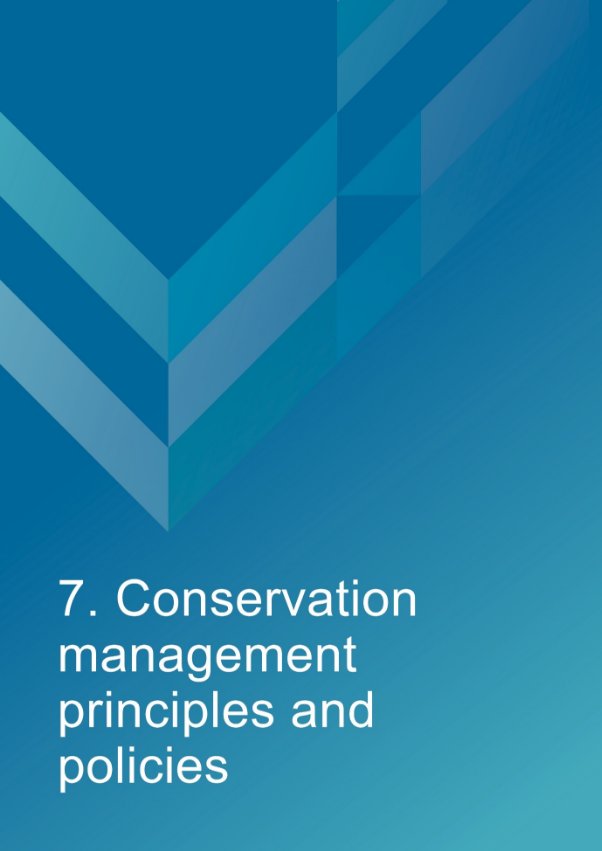
7 Conservation management principles and policies
Policies
Fabric and setting
Policy 1 – Protect and conserve the significant external and internal fabric of the lightstation, including existing buildings, layout and setting.
AMSA’s main purpose is to facilitate the ongoing operation of the site as a marine AtoN while preserving the site’s heritage values. As part of a heritage monitoring program, Heritage Asset Condition Reports are produced for each site every two years to evaluate the condition of the heritage fabric and values. Routine servicing is also carried out by maintenance contractors. Regular written reports from these visits will be sent to Asset Management and Preparedness for review and any work requirements identified will be scheduled accordingly. Should for some unforeseen reason the site no longer be viable as a marine AtoN, ownership will be passed to an appropriate state or federal authority to ensure preservation of the heritage assets.
Implementation strategy:
- AtoN Maintenance contractor will continue scheduled periodic maintenance of the lighthouse and marine aids to navigation every 12 months to ensure condition is monitored for early warning of deterioration. Schedule must be approved by AMSA Asset Management and Preparedness.
- AMSA Asset Management and Preparedness to arrange for maintenance to be carried out on the lighthouse as required while continuing to operate as an AMSA marine aids to navigation.
- AMSA Asset Management and Preparedness to arrange for the replacement and upgrading of marine aids to navigation equipment in the lighthouse as required to meet AMSA’s service commitment, in a manner that preserves the original fabric of the lighthouse.
- AMSA Asset Management and Preparedness to maintain information on the heritage fabric of the lighthouse including any and all actions, treatments and inspection outcomes within the heritage fabric register. See section 4.1 for fabric register.
- AtoN Maintenance Contractor to continue scheduled heritage monitoring visits to Cape du Couedic Lighthouse and review Heritage Asset Condition Reports.
- AMSA Asset Management and Preparedness to conserve all the fabric elements identified as significant in the heritage asset condition report.
- AMSA Asset Management and Preparedness to seek expert materials conservation advice when considering repair, restoration and reconstruction of historic fabric. The relevant local, state and federal heritage approvals must be sought prior to repair, restoration and reconstruction.
- AMSA Asset Management and Preparedness to assess any development proposals to surrounding area for possible impacts on the heritage values of Cape du Couedic Lighthouse, and liaise with the appropriate state or federal heritage authorities.
- AMSA AtoN Heritage Coordinator to conserve the distinctive character of the lighthouse by collecting photographic evidence and historical documentation of the original fabric.
Uses
Policy 2 – Install and operate equipment in the lighthouse, so it continues to function as an effective marine AtoN, in such a way as to impose the least possible harm to the significant fabric.
Cape du Couedic Lighthouse’s use as a working marine AtoN is of high priority. Carrying out maintenance, including upgrades to navigational equipment, is necessary to its function and continued marine safety along the SA coast. In the event of the installation or upgrade to AtoN equipment, proper precaution will be taken to ensure the least possible harm is done to significant fabric.
Implementation strategy:
Policy 3 – Monitor possible impacts to the site resulting from tourism and control appropriate access to the lighthouse for contractors and visitors.
Cape du Couedic Lighthouse is not currently open as a tourist site and access inside the lighthouse is restricted to authorised personnel, such as contractors and AMSA employees. AMSA personnel and contractors require easy access inside the lighthouse precinct and tower for periodical site visits to carry out inspections and routine maintenance.
Implementation strategy:
- AtoN Maintenance contractor to ensure control on access to all buildings within AMSA’s lease area is maintained by periodically inspecting buildings during maintenance visits every 12 months.
- AtoN Maintenance Contractor and AMSA Asset Management to report instances of vandalism through internal channels, assess for impact on heritage values and conduct repairs.
- AtoN Maintenance Contractor to continue remote monitoring of the site and report instances of forced entry.
- AtoN Maintenance Contractor to inspect lighthouse for signs of wear and tear during yearly maintenance visit, and note changes in Heritage Asset Condition Report.
- AMSA Asset Management and Preparedness to ensure access to the lighthouse complies with workplace health and safety measures.
- AMSA Asset Management and Preparedness to ensure contractors are made aware of the heritage values of the lighthouse.
- AMSA to assess requests for tourism activities.
- AMSA Asset Management and Preparedness to ensure access to site is available for Traditional Custodians to maintain cultural traditions.
Interpretation
Policy 4 – Accurate and relevant interpretation of the history and significance of the place should be made available to site users/visitors and for offsite external research.
AMSA will continue to make information available through the maintenance of site interpretive signage and its website.
Implementation strategy:
- All relevant information concerning the history and significance of the place will be checked for accuracy and updated appropriately.
- Information will be presented primarily as online resources accessible to relevant personnel and the general public. On-site interpretative signage will be installed where possible.
- This information will be maintained and updated in accordance with changes to the history and significance of the place.
Management
Policy 5 – AMSA will continue to conserve the lighthouse in accordance with Commonwealth and SA State heritage listing requirements.
For works requiring heritage approval, AMSA will obtain permission from any relevant state or federal authorities. Continuous and as-needed conservation works will be undertaken as required.
Implementation strategy:
Policy 6 – The cultural significance of the lightstation will be the basis for deciding how to manage it.
The heritage values or cultural significance of the place must be conserved. This heritage management plan includes relevant background information to support this policy (see ‘Section 3 History’ and ‘Section 5 Heritage significance’).
Implementation strategy:
- Conserve the lighthouse to protect its heritage values (cultural significance).
- When possible, strive to maintain the original fabric of the lightstation.
- Use the Burra Charter as the primary guide for treatment of fabric.
- Engage appropriately qualified heritage consultants when making decisions regarding impact on heritage values.
- Assess impacts on the heritage values of the place when considering proposed alterations or adaptations.
Policy 7 – Monitor, review and report the Commonwealth heritage values of the lighthouse every five years or sooner if major changes to the lightstation occur.
The Commonwealth heritage values of the lighthouse are to be monitored and reported on a regular basis. A Heritage Asset Condition Report is updated for Cape du Couedic Lighthouse every two years. The report records historical information, condition, and maintenance requirements for fabric within the lighthouse to ensure a gain and/or loss of heritage value is identified.
Implementation strategy:
- AMSA Asset Management and Preparedness to regularly monitor the lighthouse for possible impacts on the identified Commonwealth heritage values.
- AMSA Asset Management and Preparedness to review the current Commonwealth heritage values at least once every five years and assess any gain or loss of values. This review must be undertaken in the event of any major alterations to the lighthouse.
- AMSA Asset Management and Preparedness to report any changes to the Commonwealth heritage values of the lighthouse to the DCCEEW (Heritage Branch).
- AMSA Asset Management and Preparedness to update AMSA’s heritage strategy and this plan to reflect any changes identified.
- AMSA AtoN Maintenance Contractor to review and update Heritage Asset Condition Report biennially.
Policy 8 – Maintain historical, management and maintenance records within AMSA and make available these records.
As part of the proper process for managing change in significant places, the Burra Charter points out the importance of making records before any change, and advocates placing records in a permanent archive and making them available where this is appropriate. AMSA’s collection of records, which include documents pertaining to heritage intervention, management and maintenance, are subject to this process. Heritage Asset Condition Reports are routinely generated for each heritage lighthouse and stored in AMSA’s record-keeping system. AMSA will continue to practice such processes via records management systems (RMS).
Implementation strategy:
- AMSA to maintain, review and update records through existing AMSA record management system.
- AMSA to ensure records are made available to the relevant personnel and parties.
Policy 9 – Develop and provide appropriate training and resources to all relevant AMSA staff, contractors and licensees.
In order to ensure best practice management of AMSA-operated lighthouses, all staff, contractors and licensees are required to have access to the appropriate training and resources in order to provide best practice conservation of the site.
Implementation strategy:
- Provide staff, contractors and licencees access to up-to-date versions of the AMSA heritage strategy, heritage management plans and fabric registers.
- When funds are made available, AMSA Asset Management and Preparedness staff will undertake a relevant induction to ensure comprehension of the Commonwealth heritage and EPBC Act statutory requirements.
- Contractors engaged with heritage sites will undertake appropriate training to ensure comprehension of the Commonwealth heritage and EPBC Act statutory requirements.
- AMSA representatives will attend Commonwealth-run heritage workshops, programs and conferences for up-to-date information on statutory requirements and best-practice management of sites of national and state heritage significance.
- All current and incoming tour guides operating within AMSA lighthouses will be required to take the lighthouse tour guide safety induction e-learning module once every two years to stay informed on heritage values, visitor safety and lighthouse duty-of-care.
Policy 10 – Use contractors and service providers with appropriate experience.
AMSA is to ensure parties carrying out work have appropriate knowledge and use effective methods to ensure conservation of the lighthouse.
Implementation strategy:
- Engage staff and contractors with the relevant experience and expertise concerning conservation of the lightstation.
- Develop and provide the appropriate training on heritage conservation matters for AMSA Asset Management and Preparedness staff and other relevant parties who hold responsibility for heritage management.
Policy 11 – Seek heritage advice and apply best heritage practice.
AMSA will continue to use in-house heritage expertise, external consultancy, or a combination of both as required in order to successfully apply best heritage practice. Should in-house heritage expertise be limited in responding to a requirement, external heritage expertise will be engaged to address the issue.
Implementation strategy:
- Apply in-house heritage expertise when required.
- Use tools such as the Burra Charter and Working Together: Managing Commonwealth Heritage Places[xlvi] to measure the likely impact of proposals.
- Seek external heritage expertise in the event of limited in-house capability.
Policy 12 – Appropriate protocol in the event of unforeseen discoveries or disturbances of heritage within the AMSA site.
AMSA’s scope of work rarely involves excavation. Should such work need be undertaken, AMSA will implement a suitable discovery plan and seek advice from suitably qualified personnel as required. In the event of any unforeseen discovery or disturbance of heritage-related items on the AMSA site, notification to the appropriate organisation will occur in accordance with the conditions of the discovery plan. This plan will also be updated accordingly.
Note: In most cases, AMSA’s leases are limited to the immediate vicinity of the lighthouse and therefore this scenario is not anticipated as a likely occurrence.
Implementation strategy:
- Contact SA National Parks (DEW) and SA Aboriginal Affairs and Reconciliation (DPC) in the event of an unforeseen discovery/suspected discovery.
- Seek appropriate heritage advice and apply best practice in the event of unforeseen discoveries/disturbances.
Policy 13 – Make this heritage management plan available to all persons involved in decision-making on the management of the lighthouse and its setting.
The plan will be made available to all personnel intrinsic to management of the lighthouse and its setting, for example AMSA maintenance contractors, staff and other relevant parties.
Implementation strategy:
- Provide links to this plan via the AMSA publicly accessible website.
- Provide copies to all relevant personnel and parties.
Future developments
Policy 14 – Adaptation of the place using methods or processes that minimise impact on heritage values and significance in accordance with the Burra Charter principles.
It is likely that over time the lighthouse will house new equipment as technology changes and improves. The Burra Charter principles will be used as the basis for decision-making.
Implementation strategy:
- Assess the likely impacts of changes on the heritage values and significance of the place.
- Preserve the original fabric of the place and do only what is necessary for the continued use and care of the place.
- Engage expert heritage advice and use the Burra Charter in adapting the place.
Policy 15 – When required, engage with adjacent landowners to maintain an appropriate setting for the lighthouse in its visual and natural context.
Any changes to the surrounding land, or AMSA leased area, requires careful consideration. AMSA will liaise with all adjacent landowners in the event of any proposed changes that may affect the setting and attempt to influence a positive outcome.
Implementation strategy:
- AMSA Asset Management and Preparedness to engage with adjacent landowners through consultation when changes are proposed regarding the wider visual and natural context.
Policy 16 – In the event of adaptive re-use or divestment (an instance(s) which would no longer place the lighthouse under AMSA control), AMSA will strive to ensure the Commonwealth and SA State heritage values of the site are recognised and preserved.
In the event Cape du Couedic Lighthouse is no longer identified as a working AtoN, AMSA will withdraw its standing as lessee and hand over all authority to the lessor. This process must be conducted in line with s 341ZE of the EPBC Act.
Implementation strategy:
- AMSA will negotiate with lessor to have site lease terminated.
- All available heritage information within AMSA’s collection, including this heritage management plan, will be shared with the relevant parties to ensure the Commonwealth and SA State heritage values of the site are recognised and preserved.
Community Involvement
Policy 17 – Consult with Traditional Custodians and community stakeholders in the preparation of the management plan.
AMSA will give Traditional Custodians and community groups, as well as the general public, an opportunity to review and comment on this management plan through a public consultation process.
Implementation strategy:
- Undertake community consultation when preparing the heritage management plan in accordance with EPBC Regulations.
- Seek advice from Traditional Custodians and refer to Engage Early—Guidance for proponents on best practice Indigenous engagement for environmental assessments under the Environment Protection and Biodiversity Conservation Act 1999 (EPBC Act).[xlvii] to guide consultations.
Policy 18 – Manage and record sensitive information appropriately.
Sensitive information may be passed onto AMSA during consultation with stakeholders and the general public. This information will be handled in-line with AMSA’s privacy policy.
Implementation strategy:
- AMSA will record, store and manage sensitive information in-line with its privacy policy.
- No sensitive information will be included in draft or published heritage management plans.
Review
Policy 19 – Review this plan within five years of its adoption or sooner if major changes are needed.
This plan will be reviewed every five years. This review should:
- assess the content of the plan.
- determine its effectiveness in protecting the identified heritage values.
- provide any necessary recommendations for updating or re-writing of the plan. If major changes occur at the site in the interim, this plan will be reviewed and updated earlier than the specified five years.
Implementation strategy:

8 Policy implementation plan
8.1 Plan and schedule
Key Issue | Management action/task | Policies | Responsibility | Priority | Timeframe |
Conservation and preservation | Conserve the lighthouse. | 1, 2, 3, 5, 6, 10, 11, 14 | AMSA, Asset Management and Preparedness | High | Ongoing |
Review the heritage management plan every five years. | 18 | AMSA, AtoN Heritage Coordinator | Medium | 2028 (5 years following registration) |
Make this plan available to all relevant personnel. | 7, 13 | AMSA, AtoN Heritage Coordinator | High | Ongoing |
Liaison dealings | If applicable, ensure communication is maintained with adjacent landowners. | 15 | AMSA, Asset Management and Preparedness | Medium | As required |
Consult with Traditional Custodians and community stakeholders in preparing the management plan. | 17 | AMSA, AtoN Heritage Coordinator | Medium | As required |
Heritage values | Review the Commonwealth heritage values every five years. | 7 | AMSA, AtoN Heritage Coordinator | High | 2028 |
Consider heritage values when proposing new planning and/or developments. | 5, 6, 7, 14 | AMSA, AtoN Heritage Coordinator and Project Managers | High | Ongoing |
Ensure process of re-use or divestment of the site recognises and preserves heritage values. | 16 | AMSA, AtoN Heritage Coordinator | High | As required |
Conduct heritage monitoring site visit and review Heritage Asset Condition Report every two years. | 1, 7 | AMSA, Asset Management and Preparedness | High | Once every two years (ongoing) |
Staff and community awareness | Provide relevant training and awareness for management personnel (contractors and site-users). | 9 | AMSA, Asset Management and Preparedness | Medium | As required |
Ensure the availability of accurate and relevant information on the history and significance of the lighthouse for site-users and visitors. | 4 | AMSA, AtoN Heritage Coordinator | Medium | Ongoing |
Record-keeping/access | Maintain adequate record-keeping of historical, management and maintenance documents. Make these records available. | 8 | AMSA, Asset Management and Preparedness | High | Ongoing |
Expert heritage advice | Ensure knowledge and advice of heritage experts is used. | 10, 11 | AMSA, Asset Management and Preparedness | Medium | As required |
Lighthouse maintenance | Schedule periodic maintenance. | 1 | AMSA, Asset Management and Preparedness | High | Ongoing, reoccurring every 12 months |
The implementation of unforeseen discovery or disturbance processes in the event of an accidental discovery. | 12 | AMSA, Asset Management and Preparedness | Medium | As required |
Lighthouse access | Secure appropriate access to lighthouse for contractor and visitors. | 3 | AMSA, Asset Management and Preparedness | Medium | Ongoing |
8.2 Monitoring and reporting
As stipulated by Schedule 7A of the EPBC Regulations, the outlined implementation plan and associated policies listed above are required to be monitored and updated accordingly. The below review process timetable will be adhered to over the next five years:
Timeframe | Review step | Responsibility |
2026 | Plan’s half-life internal review: - Assess strengths and weaknesses of existing plan
- Address any known impact to the lighthouse’s heritage values
| AMSA, Asset Management and Preparedness |
2028 | Plan’s full-life review: - Consult with internal and external stakeholders on existing plan
- Prepare updated draft plan and consult with the Heritage Branch
- Submit reviewed plan to the Minister
| AMSA, Asset Management and Preparedness |
Other key actions in monitoring and reporting include:
- ensuring the implementation plan and policies are readily available for all relevant personnel
- delegating AMSA staff to periodically check the implementation plan is up-to-date and being utilised appropriately by the relevant personnel
- ensuring the timeframes outlined within the plan are followed
- delegating AMSA Response staff to review this plan and the associated policies at least every five years and determine whether its contents are relevant and effective in terms of continuing to conserve the place.

Appendix 1. Glossary of heritage conservation terms
The Burra Charter, from its first version (1979) and its current version (2013), defined a set of terms that have since been widely adopted in Australian heritage conservation practice.
Where the following terms are used in this heritage management plan, the particular meanings defined in the charter are intended. The definitions are quoted from Article 1 of the Burra Charter.
Adaptation means modifying a place to suit the existing use or a proposed use.
Associations means the special connections that exist between people and a place.
Compatible use means a use which respects the cultural significance of a place. Such a use involves no, or minimal, impact on cultural significance.
Conservation means all the processes of looking after a place to retain its cultural significance.
Cultural significance means aesthetic, historic, scientific, social or spiritual value for past, present or future generations. Cultural significance is embodied in the place itself, its fabric, setting, use, associations, meanings, records, related places and related objects. Places may have a range of values for different individuals or groups.
Fabric means all the physical material of the place including components, fixtures, contents, and objects.
Interpretation means all the ways of presenting the cultural significance of a place.
Maintenance means the continuous protective care of a place and its setting. Maintenance is to be distinguished from repair which involves restoration or reconstruction.
Meanings denote what a place signifies, indicates, evokes or expresses to.
Place means a geographically defined area. It may include elements, objects, spaces and view. Place may have tangible and intangible dimensions.
Preservation means maintaining a place in its existing state and retarding deterioration.
Reconstruction means returning a place to a known earlier state and is distinguished from restoration by the introduction of new material.
Related object means an object that contributes to the cultural significance of a place but is not at the place.
Related place means a place that contributes to the cultural significance of another place.
Restoration means returning a place to a known earlier state by removing accretions or by reassembling existing elements without the introduction of new material.
Setting means the immediate and extended environment of a place that is part of or contributes to its cultural significance and distinctive character.
Use means the functions of a place, including the activities and traditional and customary practices that may occur at the place or are dependant on the place.
Appendix 2. Glossary of historic lighthouse terms relevant to Cape du Couedic Lighthouse
A
Apron paving – the concrete paving surround the base of the lighthouse tower.
Astragal – the bars which support the glazing of a lantern. They may also support the roof. Simply a framing member between the glazing bars in the lantern glazing. In its true meaning an astragal is a moulding that has a rounded profile. In lanterns this is almost never the case.
B
Balcony – a walk way around the outside of the lantern, used for maintenance and (formerly, when lighthouses were manned) for observing ships. Principal parts are the balcony floor and the balcony balustrade. (Synonym: gallery deck).
Balcony floor – floor of the balcony. Cape du Couedic has a balcony floor of 1909 concrete slab.
Balcony balustrade – a handrail together with its supports. The supports are called balusters. Simply a railing or wall on the outer perimeter of the balcony, to prevent people from falling off the balcony. Generally made of metal stanchions and rails – Cape du Couedic has balcony balustrades of 1909 Chance Bros. cast iron stanchions with iron pipe rails.
Balcony door – door in the lantern base to give access to the balcony. In AMSA lanterns two doors are sometimes fitted but only one is operational. (Synonym: parapet hatch, service room door). Cape du Couedic has iron skin flat frame Chance Bros. balcony door.
C
Candelas – International unit of measurement for the luminous intensity of a light.
Cast iron – a mixture of iron and carbon with a relatively high carbon content and a low melting point, produced directly from a blast furnace.
Chance Bros – English manufacturer of optical apparatus, lanterns, cast iron stairs, cast iron towers, and other lighthouse components. The Chance family established a glass-making business in Smethwick, England in 1824 and is often described as ‘near Birmingham’. The business was absorbed into the Pilkington group of companies in 1951 and now ceases to exist.
Character – pattern of flashes of light emitted by a lighthouse, designed to identify that particular lighthouse.
Copper – a red malleable metal of low resistivity.
I
Intensity – the strength of a light measured by candelas.
Intermediate floors – levels found mid-way up a building. Cape du Couedic has three intermediate floors.
Iron – there were two common types of iron used in lighthouse construction; wrought and cast. Older lights will almost certainly contain these iron types. Wrought iron has been worked by hand and is an iron alloy with a very low carbon content in contrast to steel, it also has fibrous inclusions. Cast iron is iron which has been heated until it liquefies, and is then poured into a mould to solidify.
L
Lantern – the glazed enclosure, usually of cylindrical or polygonal shape, at the top of a lighthouse, which surrounds and protects the optical apparatus. It contains the optical apparatus, made up of the lantern roof, lantern glazing and lantern base sections.
Lantern floor – the level in a lighthouse at which the lantern is installed, and by which access may be gained to the optical system and to the inside and outside of the lantern glazing. The lantern floor is generally at or near the same level as the catwalk and cane be made from steel, concrete, or timber. Cape du Couedic has a lantern floor of 1909 reinforced concrete slab.
Lantern glazing – the middle section of the lantern, circular or polygonal in plan, between the lantern roof above and the lantern base below, made up of glass panes held in a framework of glazing bars. On the landward side there may be blank panels in place of glass, or other opaque construction. Types of lantern glazing include: flat & curved trapezoidal panes and curved diamond/triangular panes. Cape du Couedic has curved rectangular glazing panes.
Lantern roof – the roof of the lantern. Usually made of copper sheeting over a framework of rafters.
Lens assembly – a transparent optically refracting element of glass. The surface is usually spherical in form.
Light source – electric bulbs now illuminate most lighthouses.
Lighthouse – the principal structure of a lightstation, generally made up of a lantern, balcony and tower.
Lightstation – a precinct containing a lighthouse structure and other related buildings, for example. Keepers’ cottages, store room, signal house.
O
Order – a shorthand expression of the size of an optical apparatus or lantern. At the time the system of orders was established, when kerosene burners were used, longer range lights needed larger burners, and larger burners needed lens assemblies of longer focal length to ensure a sharply defined beam. Thus in turn the lantern rooms were required to be larger to house these lens assemblies. AMSA historic lantern rooms range from 1st to 4th order.
P
Pedestal – part of the optical apparatus, consisting of a metal column or base standing on the balcony floor inside the lantern and supporting the lens assembly and light source. Some later Chance documentation (such as their tariffs 1908) also refer to the lantern base as a pedestal.
T
Tower – structure to support the lantern at a sufficient height above the ground. The most common types are the masonry tower, timber-framed tower, cast iron tower, and lattice tower. Cape du Couedic has walls consisting of 1909 sandstone blocks.
Appendix 3. Table demonstrating compliance with the EPBC Regulations
Environment Protection and Biodiversity Conservation Regulations 2000 (Cth) Schedule 7A – Management Plans for Commonwealth Heritage Places |
Legislation | Satisfied within |
A management plan must: |
(a) Establish objectives for the identification, protection, conservation, presentation and transmission of the Commonwealth Heritage values of the place | Section 1 – Introduction |
(b) Provide a management framework that includes reference to any statutory requirements and agency mechanisms for the protection of the Commonwealth heritage values of the place | Section 1 – Introduction |
(c) Provide a comprehensive description of the place, including information about its location, physical features, condition, historical context and current uses | Section 2 – Cape du Couedic Lighthouse site Section 3 - History Section 4 - Fabric |
(d) Provide a description of the Commonwealth heritage values and any other heritage values of the place | Section 5 – Heritage significance |
(e) Describe the condition of the Commonwealth heritage values of the place | Section 5 – Heritage significance |
(f) Describe the method used to assess the Commonwealth heritage values of the place | Section 5 – Heritage significance |
(g) Describe the current management requirements and goals including proposals for change and any potential pressures on the Commonwealth heritage values of the place | Section 6 – Opportunities and constraints |
(h) Have policies to manage the Commonwealth heritage values of a place, and include in those policies, guidance in relation to the following: | |
i. The management and conservation processes to be used | Section 7 – Conservation management principles and policies (Policy 1, 2, 3, 5, 6, 10, 11, 14) |
ii. The access and security arrangements, including access to the area for indigenous people to maintain cultural traditions | Section 7 – Conservation management principles and policies (Policy 3) |
iii. The stakeholder and community consultation and liaison arrangements | Section 7 – Conservation management principles and policies (Policy 15, 17) |
iv. The policies and protocols to ensure that indigenous people participate in the management process | Section 7- Conservation management principles and policies (Policy 17) |
v. The protocols for the management of sensitive information | Section 7 – Conservation management principles and policies (Policy 18) |
vi. The planning and management of works, development, adaptive reuse and property divestment proposals | Section 7 – Conservation management principles and policies (Policy 16) |
vii. How unforeseen discoveries or disturbances of heritage are to be managed | Section 7 – Conservation management principles and policies (Policy 12) |
viii. How, and under what circumstances, heritage advice is to be obtained | Section 7 – Conservation management principles and policies (Policy 10, 11) |
ix. How the condition of Commonwealth heritage values is to be monitored and reported | Section 7- Conservation management principles and policies (Policy 5, 6, 7, 14) |
x. How records of intervention and maintenance of a heritage places register are kept | Section 7 – Conservation management principles and policies (Policy 7, 13) |
xi. The research, training and resources needed to improve management | Section 7 – Conservation management principles and policies (Policy 9) |
xii. How heritage values are to be interpreted and promoted | Section 7 – Conservation management principles and policies (Policy 4) |
(i) Include an implementation plan | Section 8 – Policy implementation plan |
(j) Show how the implementation of policies will be monitored | Section 8 – Policy implementation plan |
(k) Show how the management plan will be reviewed. | Section 7 – Conservation management principles and policies (Policy 19) Section 8 – Policy implementation plan |
Appendix 4. Cape du Couedic current light details
CAPE DU COUEDIC LIGHT - SA
(Est:1909, Unmanned 1957, Optic Upgrade 2008, LED light installed 2020)
IALA AVAILABILITY
CATEGORY: 2
POSITION: Latitude: 36 03.4780' S
Longitude: 136 42.3250' E
Datum: WGS 84
CHART: AUS 346
BA LIST OF LIGHTS: Q 2010
DAYMARK: White round masonry tower, red dome and white lantern,
25 metres high.
COLOUR OF LIGHT: White
CHARACTER: Fl(2) 10.0 seconds
Flash: 1.0 seconds
Short Eclipse: 2.0 seconds
Long Eclipse: 6.0 seconds
LENS: 375 mm focal radius
LIGHT SOURCE: LED: Sealite SL-LED-216-W
LANTERN: Chance 12' 1/2"
STRUCTURE: Masonry tower, 17.5m to base of lantern.
ELEVATION: 103 metres
RANGE: Nominal: 14 nautical miles
Geographical: 25.1 nautical miles
Endnotes












































































